Molotov–Ribbentrop Pact
The Molotov–Ribbentrop Pact was a non-aggression pact between Nazi Germany and the Soviet Union that enabled those two powers to divide-up Poland between them. It was signed in Moscow on August 23, 1939, by Foreign Ministers Joachim von Ribbentrop and Vyacheslav Molotov,[1] and was officially known as the Treaty of Non-Aggression between Germany and the Union of Soviet Socialist Republics.[2]
Long name:
| |
|---|---|
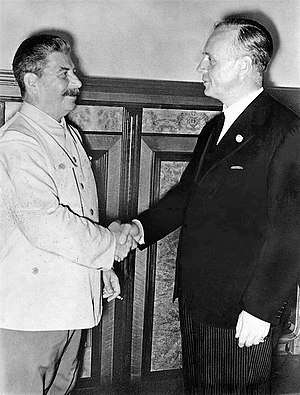 Stalin and Ribbentrop shaking hands after the signing of the pact on August 23, 1939 | |
| Signed | 23 August 1939 |
| Location | Moscow, Russian SFSR, Soviet Union |
| Expiration | 23 August 1949 (planned)22 June 1941 (terminated)30 July 1941 (officially declared null and void) |
| Signatories | |
| Languages | German and Russian |
The Pact's clauses provided a written guarantee of peace by each party towards the other and a declared commitment that neither government would ally itself to or aid an enemy of the other. In addition to the publicly-announced stipulations of non-aggression, the treaty included a secret protocol, which defined the borders of Soviet and German spheres of influence across Poland, Lithuania, Latvia, Estonia and Finland. The secret protocol also recognised the interest of Lithuania in the Vilno region, and Germany declared its complete disinterest in Bessarabia. The Secret Protocol was just a rumor until it was made public at the Nuremberg trials.[3]
Soon after the pact was finalized, Germany invaded Poland on 1 September 1939. Soviet leader Joseph Stalin ordered the Soviet invasion of Poland on 17 September, one day after a Soviet–Japanese ceasefire at the Khalkhin Gol came into effect.[4] After the invasion, the new border between the two powers was confirmed by the supplementary protocol of the German–Soviet Frontier Treaty. In March 1940, parts of the Karelia and Salla regions l, in Finland, were annexed by the Soviet Union after the Winter War. That was followed by Soviet annexations of Estonia, Latvia, Lithuania and parts of Romania (Bessarabia, Northern Bukovina and the Hertza region). Concern about ethnic Ukrainians and Belarusians had been used as pretexts for the Soviet invasion of Poland. Stalin's invasion of Bukovina in 1940 violated the pact since it went beyond the Soviet sphere of influence that had been agreed with the Axis.[5]
The territories of Poland annexed by the Soviet Union after the 1939 Soviet invasion, east of the Curzon line, remained in the Soviet Union at the end of World War II and now are parts of Ukraine and Belarus. The formerly-Polish Vilno region is now part of Lithuania, and the city of Vilnius is now the Lithuanian capital. Only the region around Białystok and a small part of Galicia east of the San River, around Przemyśl, were returned to Poland. Of all the other territories annexed by the Soviet Union in 1939 to 1940, those detached from Finland (Western Karelia, Petsamo), Estonia (Estonian Ingria and Petseri County) and Latvia (Abrene) remain part of Russia, the successor state to the Russian Soviet Federative Socialist Republic upon the dissolution of the Soviet Union in 1991. The territories annexed from Romania had also been integrated into the Soviet Union (as the Moldavian SSR or oblasts of the Ukrainian SSR). The core of Bessarabia now forms Moldova. The northern part of Bessarabia, Northern Bukovina and Hertza now form the Chernivtsi Oblast of Ukraine. Southern Bessarabia is part of the Odessa Oblast, also in Ukraine.
The pact was terminated on 22 June 1941, when Germany launched Operation Barbarossa and invaded the Soviet Union thus also executing the ideological goal of Lebensraum.[6] After the war, Ribbentrop was convicted of war crimes and executed. Molotov died at 96 in 1986, five years before the Soviet Union's dissolution. Soon after World War II, the German copy of the secret protocol was found in Nazi archives and published in the West, but the Soviet government denied its existence until 1989, when it was finally acknowledged and denounced.[7] Mikhail Gorbachev, the last leader of the Soviet Union, condemned the pact.[8] Vladimir Putin has condemned the pact as "immoral" but also defended it as a "necessary evil".[9][10] At a press conference on 19 December 2019, Putin went further and announced that the signing of the pact was no worse than the 1938 Munich agreement, which led to partition of Czechoslovakia.[11][12]
Background
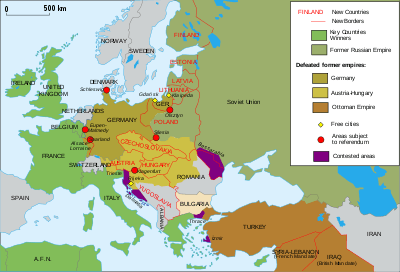
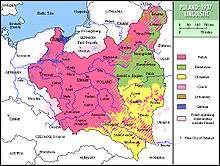
The outcome of World War I was disastrous for both the German and the Russian empires. Civil War broke out in Russia in late 1917 after the Bolshevik Revolution, and Vladimir Lenin, the first leader of the newly-formed Soviet Russia, recognised the independence of Finland, Estonia, Latvia, Lithuania and Poland. Moreover, facing a German military advance, Lenin and Trotsky were forced to enter into the Treaty of Brest-Litovsk,[13] which ceded many western Russian territories to the German Empire. After Germany's collapse, a multinational Allied-led army intervened in the Russian Civil War (1917–22).[14]
On 16 April 1922, Germany and the Soviet Union entered the Treaty of Rapallo in which they renounced territorial and financial claims against each other.[15] Each party also pledged neutrality in the event of an attack against the other with the Treaty of Berlin (1926).[16] While trade between the two countries fell sharply after World War I, trade agreements signed in the mid-1920s helped to increase trade to 433 million Reichsmarks per year by 1927.[17]
At the beginning of the 1930s, the Nazi Party's rise to power increased tensions between Germany and the Soviet Union, along with other countries with ethnic Slavs, who were considered "Untermenschen" (inferior) according to Nazi racial ideology.[18] Moreover, the anti-Semitic Nazis associated ethnic Jews with both communism and financial capitalism, both of which they opposed.[19][20] Nazi theory held that Slavs in the Soviet Union were being ruled by "Jewish Bolshevik" masters.[21] Hitler himself had spoken of an inescapable battle for the acquisition of land for Nazi Germany in the east .[22] The resulting manifestation of German anti-Bolshevism and an increase in Soviet foreign debts caused a dramatic decline in German–Soviet trade.[lower-alpha 1] Imports of Soviet goods to Germany fell to 223 million Reichsmarks in 1934 as the more isolationist Stalinist regime asserted power and the abandonment of postwar Treaty of Versailles military controls decreased Germany's reliance on Soviet imports.[17][24]
In 1936, Germany and Fascist Italy supported the Spanish Nationalists in the Spanish Civil War, but the Soviets supported the Second Spanish Republic.[25] Thus the Spanish Civil War became a proxy war between Germany and the Soviet Union.[26] In 1936, Germany and Japan entered the Anti-Comintern Pact,[27] and they were joined a year later by Italy.[28]
On 31 March 1939, Britain extended a guarantee to Poland stating that "if any action clearly threatened Polish independence, and if the Poles felt it vital to resist such action by force, Britain would come to their aid". Hitler was furious since that meant that the British were committed to political interests in Europe and that Hitler's land grabs such as the takeover of Czechoslovakia would not be taken lightly anymore. Hitler's response to the political checkmate would later be heard at a rally in Wilhelmshaven: "No power on earth would be able to break German might, and if the Western Allies thought Germany would stand by while they marshalled their 'satellite states' to act in their interests, then they were sorely mistaken." Ultimately, Hitler's discontent with a British-Polish alliance led to a restructuring of strategy towards Moscow. Alfred Rosenberg wrote that he had spoken to Hermann Goering of this potential alliance with the Soviet Union: "When Germany's life is at stake, even a temporary alliance with Moscow must be contemplated". Sometime in early May 1939 at the infamous Berghof, Ribbentrop showed Hitler a film of Stalin viewing his military in a recent parade. Hitler became intrigued with the idea, and Ribbentrop recalled Hitler saying that Stalin "looked like a man he could do business with". Thereafter, Ribbentrop was given the nod to pursue negotiations with Moscow.[29]
Munich agreement
Hitler's fierce anti-Soviet rhetoric was one of the reasons that Britain and France decided that Soviet participation in the 1938 Munich Conference on Czechoslovakia would be both dangerous and useless.[30] The Munich Agreement that followed[31] it marked a partial German annexation of Czechoslovakia in late 1938, followed by its complete dissolution in March 1939,[32] which was part of the appeasement of Germany conducted by Neville Chamberlain and Édouard Daladier's cabinets.[33] That policy immediately raised the question of whether the Soviet Union could avoid being next on Hitler's list.[34] The Soviet leadership believed that the West wanted to encourage German aggression in the East[35] and that France and Britain might stay neutral in a war initiated by Germany in the hope that the warring states would wear each other out and put an end to both regimes.[36]
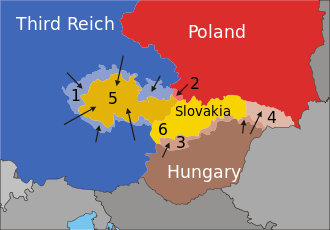
For Germany, because an autarkic economic approach or an alliance with Britain were impossible, closer relations with the Soviet Union to obtain raw materials became necessary but not only for economic reasons.[37] An expected British blockade in the event of war would also create massive shortages for Germany in a number of key raw materials.[38] After the Munich agreement, the resulting increase in German military supply needs and Soviet demands for military machinery, talks between the two countries occurred from late 1938 to March 1939.[39] The third Soviet Five Year Plan required new infusions of technology and industrial equipment.[37][40] German war planners had estimated serious shortfalls of raw materials if Germany entered a war without Soviet supply.[41]
On 31 March 1939, in response to Nazi Germany's defiance of the Munich agreement and the occupation of Czechoslovakia,[42] Britain pledged its support and that of France to guarantee the independence of Poland, Belgium, Romania, Greece and Turkey.[43] On 6 April, Poland and Britain agreed to formalise the guarantee as a military alliance, pending negotiations.[44] On 28 April, Hitler denounced the 1934 German–Polish Non-Aggression Pact and the 1935 Anglo–German Naval Agreement.[45]
In mid-March 1939, attempting to contain Hitler's expansionism, the Soviet Union, Britain and France started to trade a flurry of suggestions and counterplans regarding a potential political and military agreement.[46][47] Although informal consultations commenced in April, the main negotiations began only in May.[47] At the same time, throughout early 1939, Germany had secretly hinted to Soviet diplomats that it could offer better terms for a political agreement than Britain and France.[48][49][50]
The Soviet Union, which feared Western powers and the possibility of "capitalist encirclements", had little faith either that war could be avoided or in the Polish army, and it wanted nothing less than an ironclad military alliance with France and Britain[51] that would provide guaranteed support for a two-pronged attack on Germany;[52] thus, Stalin's adherence to the collective security line was purely conditional.[53] Britain and France believed that war could still be avoided and that the Soviet Union, weakened by the Great Purge,[54] could not be a main military participant,[52] a point with which many military sources were at variance, especially because of the Soviet victories over the Japanese Kwantung Army on the Manchurian frontier.[55] France was more anxious to find an agreement with the Soviet Union than was Britain; as a continental power, it was more willing to make concessions and also more fearful of the dangers of an agreement between the Soviet Union and Germany.[56] The contrasting attitudes partly explain why the Soviets has often been charged with playing a double game in 1939 of carrying on open negotiations for an alliance with Britain and France while it was secretly considering propositions from Germany.[56]
By the end of May, drafts were formally presented.[47] In mid-June, the main tripartite negotiations started.[57] The discussion was focused on potential guarantees to Central and Eastern Europe on the case of German aggression.[58] The Soviets proposed to consider that a political turn towards Germany by the Baltic states would constitute an "indirect aggression" towards it.[59] Britain opposed such proposals because they feared the Soviets' proposed language could either justify a Soviet intervention in Finland and the Baltic states or push those countries to seek closer relations with Germany.[60][61] The discussion about a definition of "indirect aggression" became one of the sticking points between the parties, and by mid-July, the tripartite political negotiations effectively stalled while the parties agreed to start negotiations on a military agreement, which the Soviets insisted must be entered into simultaneously with any political agreement.[62] One day before the military negotiations began, the Soviet Politburo, pessimistically expecting the coming negotiations go be going nowhere, formally decided to consider German proposals seriously.[63] The military negotiations began on 12 August in Moscow, with a British delegation headed by Sir Reginald Drax, a retired admiral, French delegation headed by General Aimé Doumenc and the Soviet delegation headed by Kliment Voroshilov, the commissar of defence, and Boris Shaposhnikov, chief of the general staff. Without written credentials, Drax was not authorised to guarantee anything to the Soviet Union and instructed by the British government to prolong the discussions as long as possible and to avoid answering the question that whether Poland would agree to permit Soviet troops to enter the country if the Germans invaded.[64] As the negotiations failed, a great opportunity to prevent the German aggression was probably lost.[65]
Negotiations
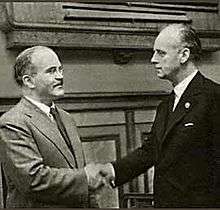
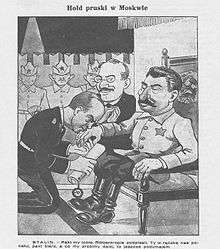
Beginning of secret talks
From April to July, Soviet and German officials made statements on the potential for the beginning of political negotiations while no actual negotiations were taking place.[66] "The Soviet Union had wanted good relations with Germany for years and was happy to see that feeling finally reciprocated", wrote historian Gerhard L. Weinberg.[67] The ensuing discussion of a potential political deal between Germany and the Soviet Union had to be channelled into the framework of economic negotiations between the two countries because close military and diplomatic connections, as was the case before the mid-1930s, had been largely severed.[68] In May, Stalin replaced his foreign minister from 1930 to 1939, Maxim Litvinov, who had advocated rapprochement with the West and who was also Jewish,[69] with Vyacheslav Molotov, allowing the Soviet Union more latitude in discussions with more parties, not only with Britain and France.[70]
On 23 August 1939, two Focke-Wulf Condors, containing German diplomats, officials and photographers (about 20 in each plane), headed by Joachim von Ribbentrop, descended into Moscow. As Nazi Party leaders stepped off the plane a Soviet military band performed, "Deutschland, Deutschland über Alles". The Nazi arrival was well planned, with all the aesthetics in order. The classic hammer and sickle was propped up next to the swastika of the Nazi flag that had been used in a local film studio for Soviet propaganda films. After stepping off the plane and the shaking of hands, Ribbentrop and Gustav Hilger along with German ambassador Friedrich-Werner von der Schulenburg and Stalin's chief bodyguard, Nikolai Vlasik, entered into a limousine operated by the NKVD to travel to the Red Square. The limousine arrived close to Stalin's office and was greeted by Alexander Poskrebyshev, the chief of Stalin's personal chancellery. Nazi Party officials were led up a flight of stairs to a room with lavish furnishings. Stalin and Foreign Minister Vyacheslav Molotov greeted the party members, much to the Nazis surprise. It was well known that Stalin avoided meeting foreign visitors and so his presence at the meeting showed how seriously the Soviets were taking the negotiations.[71]
In late July and early August 1939, Soviet and German officials agreed on most of the details of a planned economic agreement[72] and specifically addressed a potential political agreement,[73][74][75][lower-alpha 2] which the Soviets stated could only come after an economic agreement.[77]
The Nazi presence in the Soviet capital during negotiations can be regarded as rather tense. German pilot Hans Baur recalled Soviet secret police following his every move. Their job was to inform authorities when he left his residence and where he was headed. Baur's guide informed him: "Another car would tack itself onto us and follow us fifty or so yards in the rear, and wherever we went and whatever we did, the secret police would be on our heels". Hans also recalled trying to tip his Russian driver, which led to a harsh exchange of words: "He was furious. He wanted to know whether this was the thanks he got for having done his best for us to get him into prison. We knew perfectly well it was forbidden to take tips".[78]
August negotiations
In early August, Germany and the Soviet Union worked out the last details of their economic deal[79] and started to discuss a political alliance. They explained to each other the reasons for their foreign policy hostility in the 1930s, finding common ground in the anticapitalism of both countries, as the diplomats from both countries addressed the common ground of anticapitalism: "there is one common element in the ideology of Germany, Italy, and the Soviet Union: opposition to the capitalist democracies" or that "it seems to us rather unnatural that a socialist state would stand on the side of the western democracies."[80][81][82][83]
At the same time, British, French and Soviet negotiators scheduled three-party talks on military matters to occur in Moscow in August 1939 that aimed to define what the agreement would specify on the reaction of the three powers to a German attack.[60] The tripartite military talks, started in mid-August, hit a sticking point on the passage of Soviet troops through Poland if Germans attacked, and the parties waited as British and French officials overseas pressured Polish officials to agree to such terms.[84][85] Polish officials refused to allow Soviet troops into Polish territory if Germany attacked; Polish Foreign Minister Józef Beck pointed out that the Polish government feared that once the Red Army entered Polish territory, it would never leave.[86][87]
On 19 August, the 1939 German–Soviet Commercial Agreement was finally signed.[88] On 21 August, the Soviets suspended the tripartite military talks, citing other reasons.[48][89] The same day, Stalin received assurance that Germany would approve secret protocols to the proposed non-aggression pact that would place half of Poland (east of the Vistula River), Latvia, Estonia, Finland and Bessarabia in the Soviets' sphere of influence.[90] That night, Stalin replied that the Soviets were willing to sign the pact and that he would receive Ribbentrop on 23 August.[91]
News leaks
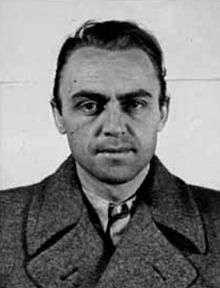
On 25 August 1939, the New York Times ran a front-page story by Otto D. Tolischus, "Nazi Talks Secret", whose subtitle included "Soviet and Reich Agree on East".[92] On 26 August 1939, the New York Times report Japanese anger[93] and French communist surprise[94] over the pact. The same day, however, Tolischus filed a story that noted Nazi troops on the move near Gleiwitz (now Gliwice), which led to the false flag Gleiwitz incident on 31 August 1939.[95] On 28 August 1939, the New York Times was still reporting on fears of a Gleiwitz raid.[96] On 29 August 1939, the New York Times reported that the Supreme Soviet had failed on its first day of convening to act on the pact.[97] The same day, the New York Times also reported from Montreal, Canada, that American Professor Samuel N. Harper of the University of Chicago had stated publicly his belief that "the Russo-German non-aggression pact conceals an agreement whereby Russia and Germany may have planned spheres of influence for Eastern Europe".[98] On 30 August 1939, the New York Times reported a Soviet buildup on its Western frontiers by moving 200,000 troops from the Far East.[99]
Secret protocol
On 22 August, one day after the talks broke down with France and Britain, Moscow revealed that Ribbentrop would visit Stalin the next day. That happened while the Soviets were still negotiating with the British and the French missions in Moscow. With the Western nations unwilling to accede to Soviet demands, Stalin instead entered a secret Nazi–Soviet pact.[100] On 23 August, a ten-year non-aggression pact was signed with provisions that included consultation, arbitration if either party disagreed, neutrality if either went to war against a third power and no membership of a group "which is directly or indirectly aimed at the other". The article "On Soviet–German Relations" in the Soviet newspaper Izvestia of 21 August 1939, stated:
Following completion of the Soviet–German trade and credit agreement, there has arisen the question of improving political links between Germany and the USSR.[101]
.gif)
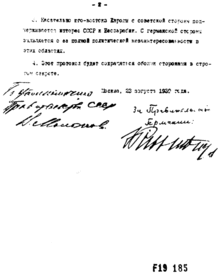
There was also a secret protocol to the pact, which was revealed only after Germany's defeat in 1945[102] although hints about its provisions were leaked much earlier, such as to influence Lithuania.[103] According to the protocol, Romania, Poland, Lithuania, Latvia, Estonia and Finland were divided into German and Soviet "spheres of influence".[102] In the north, Finland, Estonia and Latvia were assigned to the Soviet sphere.[102] Poland was to be partitioned in the event of its "political rearrangement": the areas east of the Pisa, Narev, Vistula and San Rivers would go to the Soviet Union, and Germany would occupy the west.[102] Lithuania, adjacent to East Prussia, would be in the German sphere of influence but a second secret protocol, agreed to in September 1939, and reassigned the most of Lithuania to the Soviet Union .[104] According to the protocol, Lithuania would be granted its historical capital, Vilnius, which was under Polish control during the interwar period. Another clause of the treaty stipulated that Germany would not interfere with the Soviet Union's actions towards Bessarabia, then part of Romania;[102] as a result, not only Bessarabia but also Northern Bukovina and Hertza regions were occupied by the Soviets and integrated into the Soviet Union.
At the signing, Ribbentrop and Stalin enjoyed warm conversations, exchanged toasts and further addressed the prior hostilities between the countries in the 1930s.[105] They characterised Britain as always attempting to disrupt Soviet–German relations, ll and stated that the Anti-Comintern pact was not aimed at the Soviet Union but actually aimed at Western democracies and "frightened principally the City of London [the British financiers] and the English shopkeepers".[106]
Revelation
On 24 August, Pravda and Izvestia carried news of the pact's public portions, complete with the now-infamous front-page picture of Molotov signing the treaty, with a smiling Stalin looking on.[48] The news was met with utter shock and surprise by government leaders and media worldwide, most of whom were aware only of the British–French–Soviet negotiations, which had taken place for months.[48] The pact was received with shock by Germany's allies, notably Japan; by the Comintern and foreign communist parties and by Jewish communities all around the world.[107] The same day, German diplomat Hans von Herwarth, whose grandmother was Jewish, informed Guido Relli, an Italian diplomat,[108] and American chargé d'affaires Charles Bohlen on the secret protocol on the vital interests in the countries' allotted "spheres of influence" without revealing the annexation rights for "territorial and political rearrangement".[109][110]
Time Magazine repeatedly referred to the Pact as the "Communazi Pact" and its participants as "communazis" until April 1941.[111][112][113][114][115]
Soviet propaganda and representatives went to great lengths to minimise the importance of the fact that they had opposed and fought against the Nazis in various ways for a decade prior to signing the pact. Molotov tried to reassure the Germans of his good intentions by commenting to journalists that "fascism is a matter of taste".[116] For its part, Nazi Germany also did a public volte-face regarding its virulent opposition to the Soviet Union, but Hitler still viewed an attack on the Soviet Union as "inevitable".[117]
Concerns over the possible existence of a secret protocol were expressed first by the intelligence organisations of the Baltic states only days after the pact was signed. Speculation grew stronger when Soviet negotiators referred to its content during negotiations for military bases in those countries (see occupation of the Baltic States).
The day after the pact was signed, the French and British military negotiation delegation urgently requested a meeting with Soviet military negotiator Kliment Voroshilov.[118] On 25 August, Voroshilov told them that "in view of the changed political situation, no useful purpose can be served in continuing the conversation".[118] The same day, Hitler told the British ambassador to Berlin that the pact with the Soviets prevented Germany from facing a two-front war, changing the strategic situation from that in World War I, and that Britain should accept his demands on Poland.[119]
On 25 August, surprising Hitler, Britain entered into a defense pact with Poland.[119] Hitler postponed his planned 26 August invasion of Poland to 1 September.[119][120] In accordance with the defence pact, Britain and France declared war on Germany on 3 September.[121]
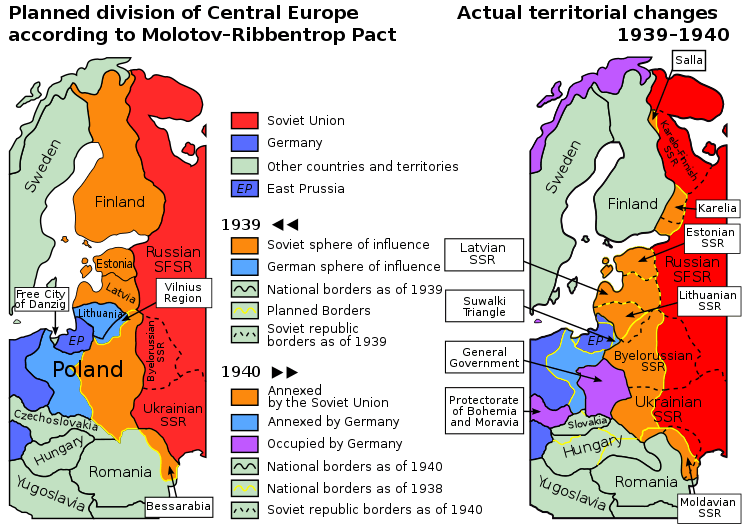
Consequences in Finland, Poland, the Baltic States and Romania
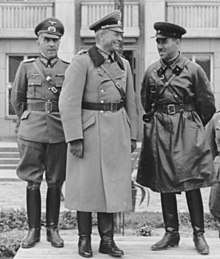
Initial invasions
On 1 September, Germany invaded Poland from the west.[122] Within a few days, Germany began conducting massacres of Polish and Jewish civilians and POWs,[123][124] which took place in over 30 towns and villages in the first month of the German occupation.[125][126][127] The Luftwaffe also took part by strafing fleeing civilian refugees on roads and by carrying out a bombing campaign.[128][129][130][131] The Soviet Union assisted German air forces by allowing them to use signals broadcast by the Soviet radio station at Minsk, allegedly "for urgent aeronautical experiments."[132] Hitler declared at Danzig:
Poland never will rise again in the form of the Versailles treaty. That is guaranteed not only by Germany, but also ... Russia.[133]
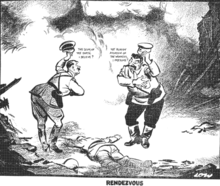
In the opinion of Robert Service, Stalin did not move instantly but was waiting to see whether the Germans would halt within the agreed area, and the Soviet Union also needed to secure the frontier in the Soviet–Japanese Border Wars.[134] On 17 September, the Red Army invaded Poland, violating the 1932 Soviet–Polish Non-Aggression Pact, and occupied the Polish territory assigned to it by the Molotov–Ribbentrop Pact. That was followed by co-ordination with German forces in Poland.[135]
Polish troops already fighting much stronger German forces on its west desperately tried to delay the capture of Warsaw. Consequently, Polish forces could not mount significant resistance against the Soviets.[136]
On 21 September, the Soviets and Germans signed a formal agreement co-ordinating military movements in Poland, including the "purging" of saboteurs.[137] Joint German–Soviet parades were held in Lvov and Brest-Litovsk, and the countries' military commanders met in the latter city.[138] Stalin had decided in August that he was going to liquidate the Polish state, and a German–Soviet meeting in September addressed the future structure of the "Polish region."[138] Soviet authorities immediately started a campaign of Sovietisation[139][140] of the newly-acquired areas. The Soviets organised staged elections,[141] the result of which was to become a legitimisation of the Soviet annexation of eastern Poland.[142]
Modification of secret protocols
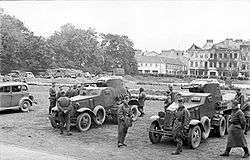
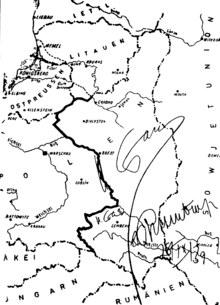
Eleven days after the Soviet invasion of the Polish Kresy, the secret protocol of the Molotov–Ribbentrop Pact was modified by the German–Soviet Treaty of Friendship, Cooperation and Demarcation,[143] allotting Germany a larger part of Poland and transferring Lithuania, with the exception of the left bank of the River Scheschupe, the "Lithuanian Strip", from the envisioned German sphere to the Soviet sphere.[144] On 28 September 1939, the Soviet Union and German Reich issued a joint declaration in which they declared:
After the Government of the German Reich and the Government of the USSR have, by means of the treaty signed today, definitively settled the problems arising from the collapse of the Polish state and have thereby created a sure foundation for a lasting peace in the region, they mutually express their conviction that it would serve the true interest of all peoples to put an end to the state of war existing at present between Germany on the one side and England and France on the other. Both Governments will, therefore, direct their common efforts, jointly with other friendly powers if the occasion arises, toward attaining this goal as soon as possible. Should, however, the efforts of the two Governments remain fruitless, this would demonstrate the fact that England and France are responsible for the continuation of the war, whereupon, in case of the continuation of the war, the Governments of Germany and of the USSR shall engage in mutual consultations with regard to necessary measures.[145]
On 3 October, Friedrich Werner von der Schulenburg, the German ambassador in Moscow, informed Joachim Ribbentrop that the Soviet government was willing to cede the city of Vilnius and its environs. On 8 October 1939, a new Nazi–Soviet agreement was reached by an exchange of letters between Vyacheslav Molotov and the German ambassador.[146]
The Baltic states of Estonia, Latvia, and Lithuania were given no choice but to sign a so-called "Pact of Defence and Mitual Assistance", which permitted the Soviet Union to station troops in them.[144]
Soviet war with Finland and Katyn massacre
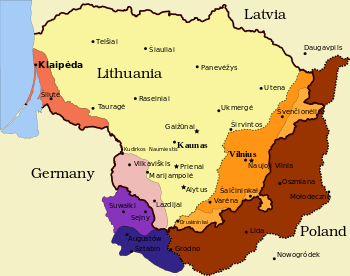
After the Baltic states had been forced to accept treaties,[147] Stalin turned his sights on Finland and was confident that its capitulation could be attained without great effort.[148] The Soviets demanded territories on the Karelian Isthmus, the islands of the Gulf of Finland and a military base near the Finnish capital, Helsinki,[149][150] which Finland rejected.[151] The Soviets staged the shelling of Mainila and used it as a pretext to withdraw from the Soviet–Finnish Non-Aggression Pact.[152] The Red Army attacked in November 1939.[153] Simultaneously, Stalin set up a puppet government in the Finnish Democratic Republic.[154] The leader of the Leningrad Military District, Andrei Zhdanov, commissioned a celebratory piece from Dmitri Shostakovich, Suite on Finnish Themes, to be performed as the marching bands of the Red Army would be parading through Helsinki.[155] After Finnish defenses surprisingly held out for over three months and inflicted stiff losses on Soviet forces, under the command of Semyon Timoshenko, the Soviets settled for an interim peace. Finland ceded southeastern areas of Karelia (10% of Finnish territory),[153] which resulted in approximately 422,000 Karelians (12% of Finland's population) losing their homes.[156] Soviet official casualty counts in the war exceeded 200,000[157] although Soviet Premier Nikita Khrushchev later claimed that the casualties may have been one million.[158]
Around that time, after several Gestapo–NKVD Conferences, Soviet NKVD officers also conducted lengthy interrogations of 300,000 Polish POWs in camps[159][160][161][162] that were a selection process to determine who would be killed.[163] On 5 March 1940, in what would later be known as the Katyn massacre,[163][164][165] 22,000 members of the military as well as intellectuals were executed, labelled "nationalists and counterrevolutionaries" or kept at camps and prisons in western Ukraine and Belarus.
Soviet Union occupies the Baltic states and part of Romania
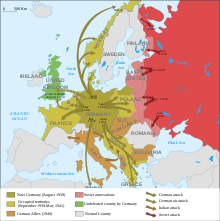
In mid-June 1940, while international attention focused on the German invasion of France, Soviet NKVD troops raided border posts in Lithuania, Estonia and Latvia.[144][166] State administrations were liquidated and replaced by Soviet cadres,[144] who deported or killed 34,250 Latvians, 75,000 Lithuanians and almost 60,000 Estonians.[167] Elections took place, with a single pro-Soviet candidates listed for many positions, and the resulting people's assemblies immediately requesting admission into the Soviet Union, which was granted.[144] (The Soviets annexed the whole of Lithuania, including the Šešupė area, which had been earmarked for Germany.)
Finally, on 26 June, four days after France had sued for an armistice with the Third Reich, the Soviet Union issued an ultimatum that demanded Bessarabia and unexpectedly Northern Bukovina from Romania.[168] Two days later, the Romanians acceded to the Soviet demands, and the Soviets occupied the territories. The Hertza region was initially not requested by the Soviets but was later occupied by force after the Romanians had agreed to the initial Soviet demands.[168] The subsequent waves of deportations began in Bessarabia and Northern Bukovina.
Beginnings of Operation Tannenberg and other Nazi atrocities
At the end of October 1939, Germany enacted the death penalty for disobedience to the German occupation.[169] Germany began a campaign of "Germanization", which meant assimilating the occupied territories politically, culturally, socially and economically into the German Reich.[170][171][172] 50,000–200,000 Polish children were kidnapped to be Germanised.[173][174]

The elimination of Polish elites and intelligentsia was part of Generalplan Ost. The Intelligenzaktion, a plan to eliminate the Polish intelligentsia, Poland's 'leadership class', took place soon after the German invasion of Poland and lasted from fall of 1939 to the spring of 1940. As the result of the operation, in ten regional actions, about 60,000 Polish nobles, teachers, social workers, priests, judges and political activists were killed.[175][176] It was continued in May 1940, when Germany launched AB-Aktion,[173] More than 16,000 members of the intelligentsia were murdered in Operation Tannenberg alone.[177]
Germany also planned to incorporate all of the land into the Third Reich.[171] That effort resulted in the forced resettlement of two million Poles. Families were forced to travel in the severe winter of 1939–1940, leaving behind almost all of their possessions without compensation.[171] As part of Operation Tannenberg alone, 750,000 Polish peasants were forced to leave, and their property was given to Germans.[178] A further 330,000 were murdered.[179] Germany planned the eventual move of ethnic Poles to Siberia.[180][181]
Although Germany used forced labourers in most other occupied countries, Poles and other Slavs were viewed as inferior by Nazi propaganda and thus better suited for such duties.[173] Between 1 and 2.5 million Polish citizens[173][182] were transported to the Reich for forced labour.[183][184] All Polish males were made to perform forced labour.[173] While ethnic Poles were subject to selective persecution, all ethnic Jews were targeted by the Reich.[182] In the winter of 1939–40, about 100,000 Jews were thus deported to Poland.[185] They were initially gathered into massive urban ghettos,[186] such as the 380,000 held in the Warsaw Ghetto, where large numbers died of starvation and diseases under its harsh conditions, including 43,000 in the Warsaw Ghetto alone.[182][187][188] Poles and ethnic Jews were imprisoned in nearly every camp of the extensive concentration camp system in German-occupied Poland and the Reich. In Auschwitz, which began operating on 14 June 1940, 1.1 million people perished.[189][190]
Romania and Soviet republics
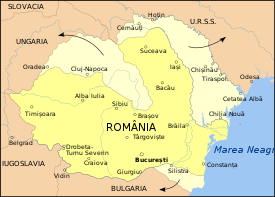
In the summer of 1940, fear of the Soviet Union, in conjunction with German support for the territorial demands of Romania's neighbours and the Romanian government's own miscalculations, resulted in more territorial losses for Romania. Between 28 June and 4 July, the Soviet Union occupied and annexed Bessarabia, northern Bukovina and the Hertza region of Romania.[191]
On 30 August, Ribbentrop and Italian Foreign Minister Galeazzo Ciano issued the Second Vienna Award, giving Northern Transylvania to Hungary. On 7 September, Romania ceded Southern Dobruja to Bulgaria (Axis-sponsored Treaty of Craiova).[192] After various events over the following months, Romania increasingly took on the aspect of a German-occupied country.[192]
The Soviet-occupied territories were converted into republics of the Soviet Union. During the two years after the annexation, the Soviets arrested approximately 100,000 Polish citizens[193] and deported between 350,000 and 1,500,000, of whom between 250,000 and 1,000,000 died, mostly civilians.[194][lower-alpha 3] Forced re-lsettlements into gulag labour camps and exile settlements in remote areas of the Soviet Union occurred.[140] According to Norman Davies,[200] almost half of them were dead by July 1940.[201]
Further secret protocol modifications settling borders and immigration issues
On 10 January 1941, Germany and the Soviet Union signed an agreement settling several ongoing issues.[202] Secret protocols in the new agreement modified the "Secret Additional Protocols" of the German–Soviet Boundary and Friendship Treaty, ceding the Lithuanian Strip to the Soviet Union in exchange for 7.5 million dollars (31.5 million Reichsmark).[202] The agreement formally set the border between Germany and the Soviet Union between the Igorka River and the Baltic Sea.[203] It also extended trade regulation of the 1940 German–Soviet Commercial Agreement until 1 August 1942, increased deliveries above the levels of the first year of that agreement,[203] settled trading rights in the Baltics and Bessarabia, calculated the compensation for German property interests in the Baltic states that were now occupied by the Soviets and covered other issues.[202] It also covered the migration to Germany within two-and-a-half months of ethnic Germans and German citizens in Soviet-held Baltic territories and the migration to the Soviet Union of Baltic and "White Russian" "nationals" in the German-held territories.[203]
Soviet–German relations
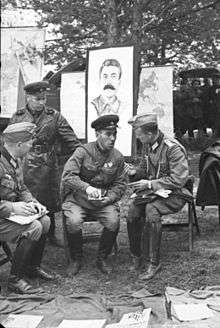
Early political issues
The agreement stunned the world. John Gunther, in Moscow in August 1939, recalled, "Nothing more unbelievable could be imagined. Astonishment and scepticism turned quickly to consternation and alarm."[204] Before the pact was announced, Western communists denied that such a treaty would be signed. Herbert Biberman, a future member of the Hollywood Ten, denounced rumours as "Fascist propaganda." Earl Browder, the head of the Communist Party USA, stated that "there is as much chance of agreement as of Earl Browder being elected president of the Chamber of Commerce."[205]
Gunther wrote, however, that some knew "communism and Fascism were more closely allied than was normally understood," and Ernst von Weizsäcker had told Nevile Henderson on 16 August that the Soviet Union would "join in sharing in the Polish spoils."[204] In September 1939, the Soviet Comintern suspended all anti-Nazi and antifascist propaganda and explained that the war in Europe was a matter of capitalist states attacking one another for imperialist purposes.[206] Western communists acted accordingly; although they had previously supported collective security, they now denounced Britain and France for going to war.[205]
When anti-German demonstrations erupted in Prague, Czechoslovakia, the Comintern ordered the Communist Party of Czechoslovakia to employ all of its strength to paralyse "chauvinist elements."[206] Moscow soon forced the French Communist Party and the Communist Party of Great Britain to adopt anti-war positions. On 7 September, Stalin called Georgi Dimitrov, who sketched a new Comintern line on the war that stated that the war was unjust and imperialist, which was approved by the secretariat of the Comintern on 9 September. Thus, western communist parties now had to oppose the war and to vote against war credits.[207] Although the French communists had unanimously voted in Parliament for war credits on 2 September and declared their "unshakeable will" to defend the country on 19 September, the Comintern formally instructed the party to condemn the war as imperialist on 27 September. By 1 October, the French communists advocated listening to German peace proposals, and leader Maurice Thorez deserted from the French Army on 4 October and fled to Russia.[208] Other communists also deserted from the army.
The Communist Party of Germany featured similar attitudes. In Die Welt, a communist newspaper published in Stockholm[lower-alpha 4] the exiled communist leader Walter Ulbricht opposed the Allies, stated that Britain represented "the most reactionary force in the world"[210]), and argued, "The German government declared itself ready for friendly relations with the Soviet Union, whereas the English–French war bloc desires a war against the socialist Soviet Union. The Soviet people and the working people of Germany have an interest in preventing the English war plan".[211]
Despite a warning by the Comintern, German tensions were raised when the Soviets stated in September that they must enter Poland to "protect" their ethnic Ukrainian and Belarusian brethren from Germany. Molotov later admitted to German officials that the excuse was necessary because the Kremlin could find no other pretext for the Soviet invasion.[212]
During the early months of the Pact, the Soviet foreign policy became critical of the Allies and more pro-German in turn. During the Fifth Session of the Supreme Soviet on 31 October 1939, Molotov analysed the international situation, thus giving the direction for communist propaganda. According to Molotov, Germany had a legitimate interest in regaining its position as a great power, and the Allies had started an aggressive war in order to maintain the Versailles system.[213]
Expansion of raw materials and military trading
Germany and the Soviet Union entered an intricate trade pact on 11 February 1940 that was over four times larger than the one that the two countries had signed in August 1939.[214] The new trade pact helped Germany surmount a British blockade.[214] In the first year, Germany received one million tons of cereals, half-a-million tons of wheat, 900,000 tons of oil, 100,000 tons of cotton, 500,000 tons of phosphates and considerable amounts of other vital raw materials, along with the transit of one million tons of soybeans from Manchuria. Those and other supplies were being transported through Soviet and occupied Polish territories.[214] The Soviets were to receive a naval cruiser, the plans to the battleship Bismarck, heavy naval guns, other naval gear and 30 of Germany's latest warplanes, including the Bf 109 and Bf 110 fighters and Ju 88 bomber.[214] The Soviets would also receive oil and electric equipment, locomotives, turbines, generators, diesel engines, ships, machine tools and samples of German artillery, tanks, explosives, chemical-warfare equipment and other items.[214]
The Soviets also helped Germany to avoid British naval blockades by providing a submarine base, Basis Nord, in the northern Soviet Union near Murmansk.[206] That also provided a refuelling and maintenance location and a takeoff point for raids and attacks on shipping.[206] In addition, the Soviets provided Germany with access to the Northern Sea Route for both cargo ships and raiders though only the commerce raider Komet used the route before the German invasion, which forced Britain to protect sea lanes in both the Atlantic and the Pacific.[215]
Summer deterioration of relations
The Finnish and Baltic invasions began a deterioration of relations between the Soviets and Germany.[216] Stalin's invasions were a severe irritant to Berlin since the intent to accomplish them had not been communicated to the Germans beforehand, and they prompted concern that Stalin was seeking to form an anti-German bloc.[217] Molotov's reassurances to the Germans and the Germans' mistrust intensified. On 16 June, as the Soviets invaded Lithuania but before they had invaded Latvia and Estonia, Ribbentrop instructed his staff "to submit a report as soon as possible as to whether in the Baltic States a tendency to seek support from the Reich can be observed or whether an attempt was made to form a bloc."[218]
In August 1940, the Soviet Union briefly suspended its deliveries under its commercial agreement after relations were strained after disagreements over policy in Romania, the Soviet war with Finland, Germany's falling behind on its deliveries of goods under the pact and Stalin's worry that Hitler's war with the West might end quickly after France signed an armistice.[219] The suspension created significant resource problems for Germany.[219] By the end of August, relations improved again, as the countries had redrawn the Hungarian and Romanian borders and settled some Bulgarian claims, and Stalin was again convinced that Germany would face a long war in the west with Britain's improvement in its air battle with Germany and the execution of an agreement between the United States and Britain regarding destroyers and bases.[220]
In the United States, "The leftists, of course, included the Communist Party, which during the 1939–1941 era of the Nazi-Soviet pact, was slavish in its effort to appease Hitler and sabotage the Allied cause and American preparedness. Their soul mate in Congress was Vito Marcantonio of New York's American Labor Party. Despite opposition from the left and the right, American aid continued to make a short war unlikely.
However, in late August, Germany arranged its own occupation of Romania, targeting its oil fields.[221] That move raised tensions with the Soviets, who responded that Germany was supposed to have consulted with the Soviet Union under Article III of the pact.[221]
German–Soviet Axis talks
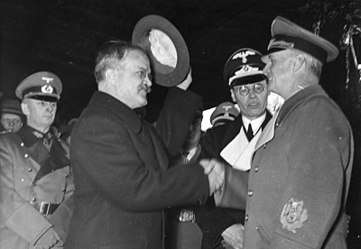
After Germany in September 1940 entered the Tripartite Pact with Japan and Italy, Ribbentrop wrote to Stalin, inviting Molotov to Berlin for negotiations aimed to create a 'continental bloc' of Germany, Italy, Japan and the Soviet Union that would oppose Britain and the United States.[222] Stalin sent Molotov to Berlin to negotiate the terms for the Soviet Union to join the Axis and potentially to enjoy the spoils of the pact.[223][224] After negotiations during November 1940 on where to extend the Soviet sphere of influence, Hitler broke off talks and continued planning for the eventual attempts to invade the Soviet Union.[222][225]
Late relations
.png)
In an effort to demonstrate peaceful intentions toward Germany, on 13 April 1941, the Soviets signed a neutrality pact with Japan, an Axis power.[226] While Stalin had little faith in Japan's commitment to neutrality, he felt that the pact was important for its political symbolism to reinforce a public affection for Germany.[227] Stalin felt that there was a growing split in German circles about whether Germany should initiate a war with the Soviet Union.[227] Stalin did not know that Hitler had been secretly discussing an invasion of the Soviet Union since summer 1940[228] and that Hitler had ordered his military in late 1940 to prepare for war in the East, regardless of the parties' talks of a potential Soviet entry as a fourth Axis power.[229]
Termination
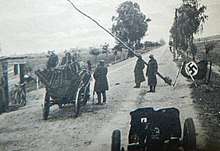
Germany unilaterally terminated the pact at 03:15 on 22 June 1941 by launching a massive attack on the Soviet Union in Operation Barbarossa.[122] Stalin had ignored repeated warnings that Germany was likely to invade[230][231][232] and ordered no "full-scale" mobilisation of forces although the mobilisation was ongoing.[233] After the launch of the invasion, the territories gained by the Soviet Union as a result of the pact were lost in a matter of weeks. The southeastern part was absorbed into Greater Germany's General Government, and the rest was integrated with the Reichskommissariats Ostland and Ukraine. Within six months, the Soviet military had suffered 4.3 million casualties,[234] and three million more had been captured.[235] The lucrative export of Soviet raw materials to Germany over the course of the economic relations continued uninterrupted until the outbreak of hostilities. The Soviet exports in several key areas enabled Germany to maintain its stocks of rubber and grain from the first day of the invasion to October 1941.[236]
Aftermath
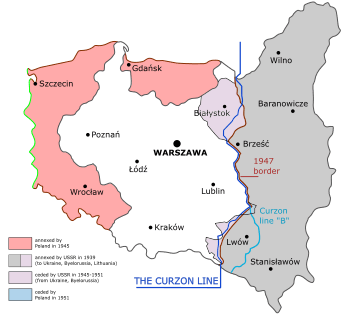
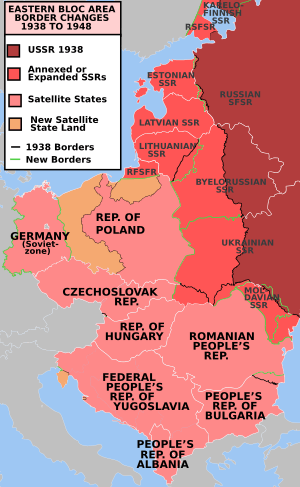
Discovery of the secret protocol
The German original of the secret protocols was presumably destroyed in the bombing of Germany,[237] but in late 1943, Ribbentrop had ordered the most secret records of the German Foreign Office from 1933 onward, amounting to some 9,800 pages, to be microfilmed. When the various departments of the Foreign Office in Berlin were evacuated to Thuringia at the end of the war, Karl von Loesch, a civil servant who had worked for the chief interpreter Paul Otto Schmidt, was entrusted with the microfilm copies. He eventually received orders to destroy the secret documents but decided to bury the metal container with the microfilms as personal insurance for his future well-being. In May 1945, von Loesch approached the British Lieutenant Colonel Robert C. Thomson with the request to transmit a personal letter to Duncan Sandys, Churchill's son-in-law. In the letter, von Loesch revealed that he had knowledge of the documents' whereabouts but expected preferential treatment in return. Thomson and his American counterpart, Ralph Collins, agreed to transfer von Loesch to Marburg, in the American zone if he would produce the microfilms. The microfilms contained a copy of the Non-Aggression Treaty as well as the Secret Protocol.[238] Both documents were discovered as part of the microfilmed records in August 1945 by US State Department employee Wendell B. Blancke, the head of a special unit called "Exploitation German Archives" (EGA).[239]
News of the secret protocols first appeared during the Nuremberg trials. Alfred Seidl, the attorney for defendant Hans Frank, was able to place into evidence an affidavit that described them. It was written from memory by Nazi Foreign Office lawyer de:Friedrich Gaus, who wrote the text and was present at its signing in Moscow. Later, Seidl obtained the German-language text of the secret protocols from an anonymous Allied source and attempted to place them into evidence while he was questioning witness Ernst von Weizsäcker, a former Foreign Office State Secretary. The Allied prosecutors objected, and the texts were not accepted into evidence, but Weizsäcker was permitted to describe them from memory, thus corroborating the Gaus affidavit. Finally, at the request of a St. Louis Post-Dispatch reporter, American deputy prosecutor Thomas J. Dodd acquired a copy of the secret protocols from Seidl and had it translated into English. They were first published on 22 May 1946 in a front-page story in that newspaper.[240] Later, in Britain, they were published by the Manchester Guardian.
The protocols gained wider media attention when they were included in an official State Department collection, Nazi–Soviet Relations 1939–1941, edited by Raymond J. Sontag and James S. Beddie and published on 21 January 1948. The decision to publish the key documents on German–Soviet relations, including the treaty and protocol, had been taken already in spring 1947. Sontag and Beddie prepared the collection throughout the summer of 1947. In November 1947, Truman personally approved the publication, but it was held back in view of the Foreign Ministers Conference in London scheduled for December. Since negotiations at that conference did not prove to be constructive from an American point of view, the document edition was sent to press. The documents made headlines worldwide.[241] State Department officials counted it as a success: "The Soviet Government was caught flat-footed in what was the first effective blow from our side in a clear-cut propaganda war."[242]
Despite publication of the recovered copy in western media, for decades, the official policy of the Soviet Union was to deny the existence of the secret protocol.[243] The secret protocol's existence was officially denied until 1989. Vyacheslav Molotov, one of the signatories, went to his grave categorically rejecting its existence.[244] The French Communist Party did not acknowledge the existence of the secret protocol until 1968, as the party de-Stalinized.[208]
On 23 August 1986, tens of thousands of demonstrators in 21 western cities, including New York, London, Stockholm, Toronto, Seattle, and Perth participated in Black Ribbon Day Rallies to draw attention to the secret protocols.[245]
Stalin's Falsifiers of History and Axis negotiations
In response to the publication of the secret protocols and other secret German–Soviet relations documents in the State Department edition Nazi–Soviet Relations (1948), Stalin published Falsifiers of History, which included the claim that during the pact's operation, Stalin rejected Hitler's claim to share in a division of the world,[246] without mentioning the Soviet offer to join the Axis. That version persisted, without exception, in historical studies, official accounts, memoirs, and textbooks published in the Soviet Union until the dissolution of the Soviet Union.[246]
The book also claimed that the Munich agreement was a "secret agreement" between Germany and "the west" and a "highly important phase in their policy aimed at goading the Hitlerite aggressors against the Soviet Union."[247][248]
Denial of the secret protocol
For decades, it was the official policy of the Soviet Union to deny the existence of the secret protocol to the Soviet–German Pact. At the behest of Mikhail Gorbachev, Alexander Nikolaevich Yakovlev headed a commission investigating the existence of such a protocol. In December 1989, the commission concluded that the protocol had existed and revealed its findings to the Congress of People's Deputies of the Soviet Union.[237] As a result, the Congress passed the declaration confirming the existence of the secret protocols and condemning and denouncing them.[249][250] Both successor states of the pact parties have declared the secret protocols to be invalid from the moment that they were signed: the Federal Republic of Germany on 1 September 1989 and the Soviet Union on 24 December 1989,[251] following an examination of the microfilmed copy of the German originals.[252]
The Soviet copy of the original document was declassified in 1992 and published in a scientific journal in early 1993.[252]
In August 2009, in an article written for the Polish newspaper Gazeta Wyborcza, Russian Prime Minister Vladimir Putin condemned the Molotov–Ribbentrop Pact as "immoral".[253][254]
The new Russian nationalists and revisionists, including Russian negationist Alexander Dyukov and Nataliya Narotchnitskaya, whose book carried an approving foreword by the Russian foreign Minister Sergei Lavrov, described the pact as a necessary measure because of the British and French failure to enter into an antifascist pact.[7][255]
Postwar commentary on motives of Stalin and Hitler
Some scholars believe that, from the very beginning of the Tripartite negotiations between the Soviet Union, Great Britain and France, it was clear that the Soviet position required the other parties to agree to a Soviet occupation of Estonia, Latvia, and Lithuania[50] and for Finland to be included in the Soviet sphere of influence.
On the timing of German rapprochement, many historians agree that the dismissal of Maxim Litvinov, whose Jewish ethnicity was viewed unfavorably by Nazi Germany, removed an obstacle to negotiations with Germany.[70][257][258][259][260][261][262][263] Stalin immediately directed Molotov to "purge the ministry of Jews."[264][260][265] Given Litvinov's prior attempts to create an anti-fascist coalition, association with the doctrine of collective security with France and Britain and a pro-Western orientation[266] by the standards of the Kremlin, his dismissal indicated the existence of a Soviet option of rapprochement with Germany.[267][lower-alpha 5] Likewise, Molotov's appointment served as a signal to Germany that the Soviet Union was open to offers.[267] The dismissal also signaled to France and Britain the existence of a potential negotiation option with Germany.[47][269] One British official wrote that Litvinov's termination also meant the loss of an admirable technician or shock-absorber but that Molotov's "modus operandi" was "more truly Bolshevik than diplomatic or cosmopolitan."[270] Carr argued that the Soviet Union's replacement of Litvinov with Molotov on 3 May 1939 indicated not an irrevocable shift towards alignment with Germany but rather was Stalin's way of engaging in hard bargaining with the British and the French by appointing a proverbial hard man to the Foreign Commissariat.[271] Historian Albert Resis stated that the Litvinov dismissal gave the Soviets freedom to pursue faster German negotiations but that they did not abandon British–French talks.[272] Derek Watson argued that Molotov could get the best deal with Britain and France because he was not encumbered with the baggage of collective security and could negotiate with Germany.[273] Geoffrey Roberts argued that Litvinov's dismissal helped the Soviets with British–French talks because Litvinov doubted or maybe even opposed such discussions.[274]
Edward Hallett Carr, a frequent defender of Soviet policy,[275] stated: "In return for 'non-intervention' Stalin secured a breathing space of immunity from German attack."[276] According to Carr, the "bastion" created by means of the pact "was and could only be, a line of defense against potential German attack."[276] According to Carr, an important advantage was that "if Soviet Russia had eventually to fight Hitler, the Western Powers would already be involved."[276][277] However, during the last decades, that view has been disputed. Historian Werner Maser stated that "the claim that the Soviet Union was at the time threatened by Hitler, as Stalin supposed... is a legend, to whose creators Stalin himself belonged.[278] In Maser's view, "neither Germany nor Japan were in a situation [of] invading the USSR even with the least perspective [sic] of success," which must not have been known to Stalin.[279] Carr further stated that for a long time, the primary motive of Stalin's sudden change of course was assumed to be the fear of German aggressive intentions.[280]
Soviet sources have claimed that soon after the pact was signed, both Britain and the US showed understanding that the buffer zone was necessary to keep Hitler from advancing for some time and accepted the ostensible strategic reasoning;[281] however, soon after World War II ended, those countries changed their view. Many Polish newspapers published numerous articles claiming that Russia must apologise to Poland for the pact.[282]
Two weeks after Soviet armies had entered the Baltic states, Berlin requested Finland to permit the transit of German troops, and five weeks later Hitler issued a secret directive "to take up the Russian problem, to think about war preparations," a war whose objective would include establishment of a Baltic confederation.[283]
Historians have debated whether Stalin was planning an invasion of German territory in the summer of 1941. Most historians agreed that the geopolitical differences between the Soviet Union and the Axis made war inevitable, and that Stalin had made extensive preparations for war and exploited the military conflict in Europe to his advantage. A number of German historians have debunked the claim that Operation Barbarossa was a preemptive strike. Such as Andreas Hillgruber, Rolf-Dieter Müller, and Christian Hartmann, they also acknowledge the Soviets were aggressive to their neighbors[284][285][286]
Remembrance
The pact was a taboo subject in the postwar Soviet Union.[287] In December 1989, the Congress of People's Deputies of the Soviet Union condemned the pact and its secret protocol as "legally deficient and invalid."[288] In modern Russia, the pact is often portrayed positively or neutrally by the pro-government propaganda; for example, Russian textbooks tend to describe the pact as a defensive measure, not as one aiming at territorial expansion.[287] In 2009, Russian President Vladimir Putin stated that "there are grounds to condemn the Pact",[289] but in 2014, he reversed the stance by describing it as routine and "necessary for Russia's survival".[290][291] Any accusation that cast doubt on one-dimensional, positive portrayal of Russia's role in World War II has been seen as highly problematic for modern Russia's state, which sees Russia's victory in the war as one of "the most venerated pillars of state ideology", which legitimises the current government and its policies.[292][293]
In 2009, the European Parliament proclaimed 23 August, the anniversary of the Molotov–Ribbentrop Pact, as the European Day of Remembrance for Victims of Stalinism and Nazism, to be commemorated with dignity and impartiality.[294] In connection with the Molotov–Ribbentrop Pact, the Organisation for Security and Co-operation in Europe parliamentary resolution condemned both communism and fascism for starting World War II and called for a day of remembrance for victims of both Stalinism and Nazism on 23 August.[295] In response to the resolution, Russian lawmakers threatened the OSCE with "harsh consequences".[295][296] A similar resolution was passed by the European Parliament a decade later, blaming the 1939 Molotov–Ribbentrop pact for the outbreak of war in Europe and again leading to criticism by Russian authorities.[292][293][297]
During the re-ignition of Cold War tensions in 1982, the US Congress during the Reagan administration established Baltic Freedom Day, to be remembered every 14 June in the United States.[298]
See also
Molotov–Ribbentrop Pact
- Baltic Way, protest marking the 50th anniversary of the Molotov–Ribbentrop Pact
- Molotov–Ribbentrop Pact negotiations
- Timeline of the Molotov–Ribbentrop Pact
- Walter Krivitsky, Soviet defector who revealed plans of the non-aggression pact before World War II
Related
- German-Soviet Axis talks
- German–Soviet military parade in Brest-Litovsk
- Italo-Soviet Pact
- Nazi–Soviet population transfers
- Soviet–Japanese Neutrality Pact
- Stalin's alleged speech of 19 August 1939
Notes
- To 53 million Reichsmarks in German imports (0.9% of Germany's total imports and 6.3% of Russia's total exports) and 34 million Reichsmarks in German exports (0.6% of Germany's total exports and 4.6% of Russia's total imports) in 1938.[23]
- On July 28, Molotov sent a political instruction to the Soviet ambassador in Berlin that marked a start of secret Soviet–German political negotiations.[76]
- The actual number of deported in the period of 1939–1941 remains unknown and various estimates vary from 350,000[195] to over 2 million, mostly World War II estimates by the underground. The earlier number is based on records made by the NKVD and does not include roughly 180,000 prisoners of war, who were also in Soviet captivity. Most modern historians estimate the number of all people deported from areas taken by Soviet Union during that period at between 800,000 and 1,500,000;[196][197] for example, RJ Rummel gives the number of 1,200,000 million;[198] Tony Kushner and Katharine Knox give 1,500,000.[199]
- Having been banned in Stockholm, it continued to be published in Zurich.[209]
- According to Paul Flewers, Stalin's address to the eighteenth congress of the Communist Party of the Soviet Union on March 10, 1939, discounted any idea of German designs on the Soviet Union. Stalin had intended: "To be cautious and not allow our country to be drawn into conflicts by warmongers who are accustomed to have others pull the chestnuts out of the fire for them." This was intended to warn the Western powers that they could not necessarily rely upon the support of the Soviet Union.[268]
References
Citations
- Zabecki, David (2014). Germany at war : 400 years of military history. Santa Barbara, California: ABC-CLIO, LLC. p. 536. ISBN 978-1-59884-981-3.
- "Faksimile Nichtangriffsvertrag zwischen Deutschland und der Union der Sozialistischen Sowjetrepubliken, 23. August 1939 / Bayerische Staatsbibliothek (BSB, München)". 1000dokumente.de. Retrieved March 14, 2020.
- Senn, Alfred (January 1990). "Perestroika in Lithuanian Historiography: The Molotov-Ribbentrop Pact". The Russian Review. 49 (1): 44–53. doi:10.2307/130082. JSTOR 130082.
- Goldman 2012, pp. 163–64.
- Brackman, Roman The Secret File of Joseph Stalin: A Hidden Life (2001) p. 341
- "German-Soviet Pact". Holocaust Encyclopedia. United States Holocaust Memorial Museum. Retrieved April 7, 2019.
- "Russian historians defend the Molotov-Ribbentrop Pact".
- Bershidsky, Leonid (September 18, 2018). "Russia Must Own Up to Stalin-Hitler Romance (Op-Ed)". The Moscow Times.
- Parfitt, Tom (November 6, 2014). "Vladimir Putin says there was nothing wrong with Soviet Union's pact with Adolf Hitler's Nazi Germany". Daily Telegraph. Retrieved May 20, 2015.
- Timothy Snyder, NYreview of books,putin nostalgia hitler stalin
- The great press-conference of Vladimir Putin (Большая пресс-конференция Владимира Путина). President of Russia. 19 December 2019 (in Russian)
- Ivan Beliayev. Putin and pigs: social networks about interest of the president to history (Путин и свиньи: соцсети о странном интересе президента к истории). Radio Free Europe/Radio Liberty. 26 December 2019 (in Russian)
- "Peace Treaty of Brest-Litovsk". BYU. March 3, 1918. Cite journal requires
|journal=(help)CS1 maint: ref=harv (link). - Montefiore 2005, p. 32.
- "German–Russian agreement". Rapallo: Mt Holyoke. April 16, 1922. Cite journal requires
|journal=(help)CS1 maint: ref=harv (link). - "Treaty of Berlin Between the Soviet Union and Germany". Yale. April 24, 1926. Cite journal requires
|journal=(help)CS1 maint: ref=harv (link). - Ericson 1999, pp. 14–5.
- Bendersky 2000, p. 177.
- Lee, Stephen J; Paul, Shuter (1996). Weimar and Nazi Germany. Heinemann. p. 33. ISBN 0-435-30920-X..
- Bendersky 2000, p. 159.
- Müller, Rolf-Dieter; Ueberschär, Gerd R (2002). Hitler's War in the East, 1941–1945: A Critical Assessment. Berghahn. p. 244. ISBN 978-1-57181-293-3..
- Kershaw, Ian (April 17, 2000). Hitler: 1889-1936 Hubris. W. W. Norton & Company. ISBN 978-0-393-25420-4.
- Ericson, Edward E III (May 1998). "Karl Schnurre and the Evolution of Nazi–Soviet Relations, 1936–1941". German Studies Review. 21 (2): 263–83. doi:10.2307/1432205. JSTOR 1432205.CS1 maint: ref=harv (link).
- Hehn 2005, p. 212.
- Jurado, Carlos Caballero; Bujeiro, Ramiro (2006). The Condor Legion: German Troops in the Spanish Civil War. Osprey. pp. 5–6. ISBN 1-84176-899-5..
- Lind, Michael (2002). Vietnam, the Necessary War: A Reinterpretation of America's Most Disastrous Military Conflict. Simon & Schuster. p. 59. ISBN 978-0-684-87027-4..
- Gerhard, Weinberg (1970). The Foreign Policy of Hitler's Germany Diplomatic Revolution in Europe 1933–36. Chicago: University of Chicago Press. p. 346..
- Spector, Robert Melvin. World Without Civilization: Mass Murder and the Holocaust, History, and Analysis. p. 257..
- Roger, Moorhouse. The devils' alliance : Hitler's pact with Stalin, 1939-41. London. ISBN 9780099571896. OCLC 934937192.
- "Hitler and Russia". The Times. London. June 24, 1941..
- "Agreement concluded at between Germany, Great Britain, France and Italy". Munich: Yale. September 29, 1938. Cite journal requires
|journal=(help) - Kershaw 2001, pp. 157–8.
- Kershaw 2001, p. 124.
- Beloff, Max (October 1950). "Soviet Foreign Policy, 1929–41: Some Notes". Soviet Studies. 2 (2): 123–37. doi:10.1080/09668135008409773.CS1 maint: ref=harv (link).
- Kershaw 2001, p. 194.
- Carr 1949.
- Ericson 1999, pp. 1–2.
- Ericson 1999, pp. 3–4.
- Ericson 1999, pp. 29–35.
- Hehn 2005, pp. 42–43.
- Ericson 1999, p. 44.
- Collier, Martin; Pedley, Philip. Germany, 1919–45..
- Kinder, Hermann; Hilgemann, Werner (1978). The Anchor Atlas of World History. II. New York: Anchor Press, Doubleday. p. 165. ISBN 0-385-13355-3..
- Crozier, Andrew J. The Causes of the Second World War. p. 151..
- Brown, Robert J (January 1, 2004). Manipulating the Ether: The Power of Broadcast Radio in Thirties America. ISBN 0-7864-2066-9..
- Carley 1993.
- Watson 2000, pp. 696–8.
- Roberts 2006, p. 30.
- "Tentative Efforts To Improve German–Soviet Relations, April 17 – August 14, 1939". Yale..
- Grogin, Robert C (2001). Natural Enemies: The United States and the Soviet Union in the Cold War, 1917–1991. Lexington. p. 28..
- Carley 1993, p. 324.
- Watson 2000, p. 695.
- Roberts, G (December 1997). "The Journal of Modern History" (review of Raack, R, Stalin's Drive to the West, 1938–1945: The Origins of the Cold War). 69 (4): 787. Cite journal requires
|journal=(help)CS1 maint: ref=harv (link). - Watt 1989, p. 118.
- Carley 1993, pp. 303–41.
- Watson 2000, p. 696.
- Watson 2000, p. 704.
- Carley 1993, pp. 322–3.
- Watson 2000, p. 708.
- Shirer 1990, p. 502.
- Hiden, John (2003). The Baltic and the Outbreak of the Second World War. Cambridge University Press. p. 46. ISBN 0-521-53120-9..
- Watson 2000, pp. 710–1.
- Gromyko, Andrei; Ponomarev, B. N. Ponomarev (1981). Soviet foreign policy : 1917-1980 Collectible Soviet foreign policy : 1917-1980. Progressive Publishers. p. 89..
- Butler, Susan (2016). Roosevelt and Stalin: Portrait of a Partnership. Vintage Books. p. 173. ISBN 9780307741813..
- Stalin 'planned to send a million troops to stop Hitler if Britain and France agreed pact'
- Nekrich, Ulam & Freeze 1997, pp. 107–11.
- Gerhard L. Weinberg (2010). Hitler's Foreign Policy 1933-1939: The Road to World War II. p. 749. ISBN 9781936274840.
- Ericson 1999, p. 46.
- P. Tsygankov, Andrei (2012). Russia and the West from Alexander to Putin: Honor in International Relations. Cambridge University Press. p. 260. ISBN 978-1139537001.
- Nekrich, Ulam & Freeze 1997, pp. 109–10.
- Roger, Moorhouse. The devils' alliance : Hitler's pact with Stalin, 1939-41. London. ISBN 9780099571896. OCLC 934937192.
- Fest 2002, p. 588.
- Ulam 1989, pp. 509–10.
- Shirer 1990, p. 503.
- Roberts 1992a, p. 64.
- Roberts 1992a, pp. 64–67.
- Ericson 1999, pp. 54–5.
- Roger, Moorhouse. The devils' alliance : Hitler's pact with Stalin, 1939-41. London. ISBN 9780099571896. OCLC 934937192.
- Ericson 1999, p. 56.
- Nekrich, Ulam & Freeze 1997, p. 115.
- Fest 2002, pp. 589–90.
- Bertriko, Jean-Jacques; Subrenat, A; Cousins, David (2004). Estonia: Identity and Independence. Rodopi. p. 131. ISBN 90-420-0890-3..
- "Hitler and Stalin Weren't Such Strange Bedfellows". The Wall Street Journal. August 22, 2019.
- Watson 2000, p. 713.
- Shirer 1990, p. 536.
- Shirer 1990, p. 537.
- Cienciala, Anna M (2006) [2004]. "The Coming of the War and Eastern Europe in World War II" (lecture notes). University of Kansas. Cite journal requires
|journal=(help)CS1 maint: ref=harv (link). - Shirer 1990, p. 525.
- Watson 2000, p. 715.
- Murphy, David E (2006). What Stalin Knew: The Enigma of Barbarossa. Yale University Press. p. 23. ISBN 0-300-11981-X..
- Shirer 1990, p. 528.
- Tolischus, Otto D. (August 25, 1939). "Nazi Talks Secret: Hitler Lays Plans with His Close Aides for the Partition of Poland". New York Times. p. 1. Retrieved January 2, 2019.
- Byas, Hugh (August 26, 1939). "Japanese Protest Hitler-Stalin Pact". New York Times. p. 1. Retrieved January 2, 2019.
- "Paris Communists Stunned by Accord". New York Times. August 26, 1939. p. 2. Retrieved January 2, 2019.
- Tolischus, Otto D. (August 26, 1939). "Berlin Talks Held: Nazi Quarters Now Feel General European war Has Been Averted". New York Times. p. 1. Retrieved January 2, 2019.
- "Polish Made Easy for Reich Troops: Booklet on Sale Has Phonetic Aid—'Good Day, Mr. Mayor' Is the Opening Phrase: GLEIWITZ FEARS RAIDS". New York Times. August 28, 1939. p. 2. Retrieved January 2, 2019.
- "Soviet Fails to Act on Pact With Reich". New York Times. August 28, 1939. p. 1. Retrieved January 2, 2019.
- "See Secret in Accord: Dr. Harper Says Stalin-Hitler Pact May Prove an Alliance". New York Times. August 28, 1939. p. 11. Retrieved January 2, 2019.
- "Russian Massing Soldiers in West". New York Times. August 30, 1939. p. 1. Retrieved January 2, 2019.
- Watt 1989, p. 367.
- Media build up to World War II, BBC News, August 24, 2009
- "Text of the Nazi–Soviet Non-Aggression Pact". Fordham. August 23, 1939. Cite journal requires
|journal=(help)CS1 maint: ref=harv (link). - Ceslovas Laurinavicius, "The Lithuanian Reaction to the Loss of Klaipeda and the Combined Gift of Soviet "Security Assistance and Vilnius", in: Northern European Overture to War, 1939–1941: From Memel to Barbarossa, 2013, ISBN 90-04-24909-5
- Christie, Kenneth (2002). Historical Injustice and Democratic Transition in Eastern Asia and Northern Europe: Ghosts at the Table of Democracy. RoutledgeCurzon. ISBN 0-7007-1599-1..
- Shirer 1990, p. 539.
- Shirer 1990, p. 540.
- van Dijk, Ruud, ed. (2008). Encyclopedia of the Cold War. London. p. 597. ISBN 978-0-415-97515-5..
- Wegner, Bernd, ed. (1997). From Peace to War: Germany, Soviet Russia and the World, 1939–1941. Providence and Oxford: Berghahn. p. 507. ISBN 978-1-57181-882-9..
- Dębski, Sławomir (2007). Między Berlinem a Moskwą. Stosunki niemiecko-sowieckie 1939–1941. Warszawa: Polski Instytut Spraw Międzynarodowych. ISBN 978-83-89607-08-9..
- Dunn, Dennis J (1998). Caught Between Roosevelt & Stalin: America's Ambassadors to Moscow. University Press of Kentucky. pp. 124–5. ISBN 0-8131-2023-3..
- "Moscow's Week". Time. October 9, 1939..
- "Revival". Time. October 9, 1939..
- "Communazi Columnists". Time. June 3, 1940..
- Chambers, Whittaker (January 6, 1941). "The Revolt of the Intellectuals". Time.
- "In Again, Out Again". Time. April 7, 1941..
- Sheen, Fulton John (1948). Communism and the Conscience of the West. Bobbs–Merrill. p. 115..
- "The Soviet Union and the Eastern Front". encyclopedia.ushmm.org. Retrieved January 26, 2019.
- Shirer 1990, pp. 541–2.
- Nekrich, Ulam & Freeze 1997, p. 123.
- McDonough, Frank. Neville Chamberlain, Appeasement and the British Road to War. p. 86..
- Black, Jeremy (2012). Avoiding Armageddon: From the Great War to the Fall of France, 1918–40. A&C Black. p. 251. ISBN 978-1-4411-5713-3.
- Roberts 2006, p. 82
- Datner 1962, p. 11.
- Garvin, JL. "German Atrocities in Poland". Free Europe: 15. Cite journal requires
|journal=(help)CS1 maint: ref=harv (link). - Datner, Gumkowski & Leszczynski 1962, pp. 127–34.
- "Um Swiecie". PL. Archived from the original on March 31, 2009.CS1 maint: ref=harv (link).
- Gilbert, Martin (1990). The Holocaust. Fontana. pp. 85–88. ISBN 0-00-637194-9..
- Davies 1986, p. 437.
- Cyprian & Sawicki 1961, p. 65.
- The German New Order in Poland: Part One. Felsztyn. Tripod. Archived from the original on February 1, 2009. Retrieved January 23, 2009.CS1 maint: ref=harv (link).
- Datner, Gumkowski & Leszczynski 1962, p. 18.
- АВП СССР, ф. 06, оп. 1, п. 8, д. 74, л. 20. л. 26. Item 4: "Hilger asked to pass the request of the German Air forces' Chief of Staff (the Germans wanted the radio station in Minsk, when it is idle, to start a continuous broadcast needed for urgent aeronautical experiments. This translation should contain the embedded call signs "Richard Wilhelm 1.0", and, in addition to that, to broadcast the word "Minsk" as frequent as possible. The Molotov's resolution on that document authorised broadcasting of the word "Minsk" only)."
- "Seven Years War?". Time. October 2, 1939..
- Service 2003, p. 256.
- Roberts 2006, p. 43.
- Zaloga, Steven J (2002). Poland 1939. Botley, UK: Osprey. p. 80..
- Nekrich, Ulam & Freeze 1997, p. 130.
- Nekrich, Ulam & Freeze 1997, p. 131.
- Sudoł, Adam, ed. (1998). Sowietyzacja Kresów Wschodnich II Rzeczypospolitej po 17 września 1939 (in Polish). Bydgoszcz: Wyższa Szkoła Pedagogiczna. p. 441. ISBN 83-7096-281-5.
- Weiner, Myron; Russell, Sharon Stanton, eds. (2001). "Stalinist Forced Relocation Policies". Demography and National Security. Berghahn Books. pp. 308–15. ISBN 1-57181-339-X.
- Kozłowski, Bartłomiej (2005). ""Wybory" do Zgromadzeń Ludowych Zachodniej Ukrainy i Zachodniej Białorusi". Polska (in Polish). PL: NASK. Archived from the original on June 28, 2006. Retrieved March 13, 2006.
- Gross, Jan Tomasz (2003). Revolution from Abroad. Princeton: Princeton University Press. p. 396. ISBN 0-691-09603-1..
- "German–Soviet Boundary and Friendship Treaty". Yale. Cite journal requires
|journal=(help)CS1 maint: ref=harv (link). - Wettig, Gerhard (2008). Stalin and the Cold War in Europe. Landham, MD, US: Rowman & Littlefield. pp. 20–21. ISBN 978-0-7425-5542-6.
- "Declaration of the Government of the German Reich and the Government of the USSR of September 28, 1939". Yale. Archived from the original on November 26, 2005. Cite journal requires
|journal=(help)CS1 maint: ref=harv (link). - Domas, Krivickas (Summer 1989). "The Molotov–Ribbentrop Pact of 1939: Legal and Political Consequences". Lituanus. 34 (2). ISSN 0024-5089.CS1 maint: ref=harv (link).
- Engle & Paananen 1985, p. 6.
- Turtola 1999, pp. 35–37.
- Turtola 1999, pp. 32–33.
- Trotter 2002, pp. 12–13.
- Edwards 2006, p. 55.
- Turtola 1999, pp. 44–45.
- Kennedy-Pipe, Caroline (1995). Stalin's Cold War. New York: Manchester University Press. ISBN 0-7190-4201-1..
- Chubaryan & Shukman 2002, p. xxi.
- Edwards 2006, p. 98.
- Engle & Paananen 1985, pp. 142–3.
- Roberts 2006, p. 52.
- Mosier, John (2004). The Blitzkrieg Myth: How Hitler and the Allies Misread the Strategic Realities of World War II. HarperCollins. p. 88. ISBN 0-06-000977-2..
- "Obozy jenieckie żołnierzy polskich" [Prison camps for Polish soldiers] (in Polish). PL: Internetowa encyklopedia PWN. Archived from the original on November 4, 2013. Retrieved November 28, 2006..
- "Edukacja Humanistyczna w wojsku". Dom wydawniczy Wojska Polskiego [Official publication of the Polish Army] (PDF) (in Polish). PL. 2005. ISSN 1734-6584. Archived from the original (PDF) on March 7, 2008.CS1 maint: ref=harv (link).
- "Молотов на V сессии Верховного Совета 31 октября цифра "примерно 250 тыс."" (in Russian). Cite journal requires
|journal=(help)CS1 maint: ref=harv (link) - "Отчёт Украинского и Белорусского фронтов Красной Армии Мельтюхов, с. 367.". USA truth (in Russian). RU: By.CS1 maint: ref=harv (link)
- Fischer, Benjamin B (Winter 1999–2000). "The Katyn Controversy: Stalin's Killing Field". Studies in Intelligence. US: CIA.CS1 maint: ref=harv (link)
- Sanford, George (2005). Katyn and the Soviet Massacre of 1940: Truth, Justice and Memory (Google Books). BASEES – Russian and East European studies: British Association for Soviet, Slavonic and East European Studies. 20. Routledge. pp. 20–24. ISBN 978-0-415-33873-8..
- "Stalin's Killing Field" (PDF). CIA. Retrieved July 19, 2008.
- Senn, Alfred Erich (2007). Lithuania 1940: Revolution from Above. Amsterdam, New York: Rodopi. ISBN 978-90-420-2225-6..
- Montefiore 2005, p. 334.
- Roberts 2006, p. 55.
- Pogonowski, Iwo (1998). Jews in Poland. Hippocrene. p. 101. ISBN 0-7818-0604-6..
- Halecki 1983, p. 312.
- Garlinski 1987, p. 28.
- "Forgotten". Remember..
- "USHMM".CS1 maint: ref=harv (link).
- Cyprian & Sawicki 1961, pp. 83–91.
- Wardzyńska, Maria (2009). Był rok 1939 Operacja niemieckiej policji bezpieczeństwa w Polsce. Intelligenzaktion (in Polish). IPN Instytut Pamięci Narodowej. ISBN 978-83-7629-063-8..
- Meier, Anna (2008). Die Intelligenzaktion: Die Vernichtung Der Polnischen Oberschicht Im Gau Danzig-Westpreusen. VDM Verlag Dr. Müller. ISBN 978-3-639-04721-9..
- Garlinski 1987, p. 27.
- Davies 1986, p. 446.
- Zamoyski, Adam (1989). The Polish Way. John Murray. p. 358. ISBN 0-7195-4674-5..
- Cyprian & Sawicki 1961, p. 73.
- Datner, Gumkowski & Leszczynski 1962, p. 8.
- "Nazi German Camps on Polish Soil During World War II". PL: MSZ..
- Piotrowski 2007, p. 22.
- Cyprian & Sawicki 1961, p. 139.
- Garlinski 1987, p. 29.
- Halecki 1983, p. 313.
- Berenbaum, Michael (2006). "The World Must Know". United States Holocaust Memorial Museum: 114. Cite journal requires
|journal=(help)CS1 maint: ref=harv (link). - "Deportations to and from the Warsaw Ghetto". US: Holocaust Memorial Museum..
- Harmon, Brian; Drobnicki, John. "Historical sources and the Auschwitz death toll estimates". Techniques of denial. The Nizkor Project. Archived from the original on January 16, 2009. Retrieved January 23, 2009. External link in
|publisher=(help). - Piper, Franciszek; Meyer, Fritjof (2002). "Die Zahl der Opfer von Auschwitz. Neue Erkentnisse durch neue Archivfunde". Osteuropa (review article) (in German). PL: Auschwitz. 52, Jg (5): 631–41. Archived from the original on May 21, 2011.CS1 maint: ref=harv (link).
- Vladimir Beshanov (2008). Czerwony Blitzkrieg (in Polish). PL: Inicjał. pp. 250–62. ISBN 978-83-926205-2-5..
- Wasserstein, Bernard (2007). Barbarism and Civilization: A History of Europe in Our Time. Oxford University Press. p. 305. ISBN 978-0-19-873074-3..
- "Represje 1939–41 Aresztowani na Kresach Wschodnich" [Repressions 1939–41. Arrested on the Eastern Borderlands] (in Polish). PL: Ośrodek Karta. Archived from the original on December 10, 2006. Retrieved November 15, 2006. Cite journal requires
|journal=(help)CS1 maint: ref=harv (link). - Rieber, pp. 14, 32–37.
- "Okupacja Sowiecka w Polsce 1939–41". Internetowa encyklopedia PWN (in Polish). Retrieved March 14, 2006..
- Wierzbicki, Marek; Płużański, Tadeusz M (March 2001). "Wybiórcze traktowanie źródeł". Tygodnik Solidarność (March 2, 2001).CS1 maint: ref=harv (link)
- Głowacki, Albin (September 2003). Chmielowiec, Piotr (ed.). Formy, skala i konsekwencje sowieckich represji wobec Polaków w latach 1939–1941. Okupacja sowiecka ziem polskich 1939–1941 (in Polish). Rzeszów-Warsaw: Instytut Pamięci Narodowej. ISBN 83-89078-78-3. Archived from the original on October 3, 2003.
- Rummel, RJ (1990). Lethal Politics: Soviet Genocide and Mass Murder Since 1917. p. 132. ISBN 978-1-4128-2750-8..
- Kushner, Tony; Knox, Katharine (1999). Refugees in an Age of Genocide. p. 219. ISBN 978-0-7146-4783-8..
- Davies, Norman (1982). God's Playground. A History of Poland. 2: 1795 to the Present. Oxford: Oxford University Press. pp. 449–55. ISBN 0-19-925340-4.
- Wegner, Bernd (1997). From Peace to War: Germany, Soviet Russia, and the World, 1939–1941 (Google books). Berghahn Books. p. 78. ISBN 1-57181-882-0..
- Ericson 1999, pp. 150–3.
- Johari, JC (2000). Soviet Diplomacy 1925–41. 1925–27. Anmol. pp. 134–7. ISBN 81-7488-491-2..
- Gunther, John (1940). Inside Europe. New York: Harper & Brothers. pp. 137–138.
- Friedrich, Otto (1997). City of Nets: A Portrait of Hollywood in the 1940s (reprint ed.). Berkeley; Los Angeles: University of California Press. p. 24. ISBN 0-520-20949-4.
- Cohen, Yohanon (1989). Small Nations in Times of Crisis and Confrontation. SUNY Press. p. 110. ISBN 0-7914-0018-2..
- "From the Red Flag to the Union Jack". What next journal. UK. Archived from the original on February 23, 2006. Retrieved February 14, 2006.CS1 maint: ref=harv (link).
- Jackson, Julian (2001). France: The Dark Years, 1940–1944. Oxford University Press. pp. 18, 114–15. ISBN 0-19-820706-9.
- "Som von Außen", Sozmit, DE: FES.
- "Sozialistische Mitteilungen" (8). DE: FES. 1940. Cite journal requires
|journal=(help)CS1 maint: ref=harv (link). - Hofer, Walther (2007). Die Entfesselung des Zweiten Weltkrieges. Lit. pp. 224–5. ISBN 978-3-8258-0383-4.
Die Welt, February 1940.
- Nekrich, Ulam & Freeze 1997, pp. 128–9.
- Pietrow-Ennker, Bianka (2000). "Stalinistische Außen- und Deutschlandpolitik 1939–1941". In Pietrow-Ennker, Bianka (ed.). Präventivkrieg? Der deutsche Angriff auf die Sowjetunion (3 ed.). Frankfurt am Main: Fischer. p. 85. ISBN 978-3-596-14497-6.
- Shirer 1990, pp. 668–9.
- Philbin 1994, pp. 130–42.
- Kennan, George (1961). Russian and the West, under Lenin and Stalin. NY: Mentor. pp. 318–9..
- Cartier, Raymond (1962). Hitler et ses Généreaux [Hitler and his Generals] (in French). Paris: J'ai Lu/A. Faiard. p. 233..
- Sontag, RJ; Beddie, JS, eds. (1948). Nazi–Soviet Relations 1939–1941. Washington, DC: State Department. p. 151.CS1 maint: ref=harv (link).
- Philbin 1994, pp. 48, 59.
- Philbin 1994, p. 60.
- Shirer 1990, p. 720.
- Roberts 2006, p. 59.
- Roberts 2006, p. 58.
- Brackman 2001, p. 341.
- Nekrich, Ulam & Freeze 1997, pp. 202–5.
- Roberts 2006, p. 63.
- Roberts 2006, p. 66.
- Ericson 1999, pp. 129–30.
- Weeks, Albert L (2003). Stalin's Other War: Soviet Grand Strategy, 1939–1941. Rowman & Littlefield. pp. 74–5. ISBN 0-7425-2192-3..
- Roberts 2006, p. 67
- Ferguson, Niall (June 12, 2005). "Stalin's Intelligence". Review of books by Murphy, Pleshakov, and Service. The New York Times. Retrieved March 27, 2010.
- Roberts 2006, pp. 67–68
- Roberts 2006, p. 69
- Roberts 2006, pp. 116–117
- Roberts 2006, p. 85
- Ericson 1999, pp. 202–205
- Dreifeilds, Juris (1996). Latvia in Transition. Cambridge University Press. pp. 34–5. ISBN 0-521-55537-X..
- Eckert 2012, pp. 62–67.
- "Record Group 84, POLAD, Classified General Correspondence, 1945–49". National Archives and Record Administration. Box 100. [Archive] Location 350/57/18/02. Cite journal requires
|journal=(help)CS1 maint: ref=harv (link). - Stokes, Richard L. (May 22, 1946). "Secret Soviet-Nazi Pacts on Eastern Europe Aired: Purported Texts on Agreed Spheres of Influence Produced at Nuernberg but Not Admitted at Trial". St. Louis Post-Dispatch. p. 1. Retrieved May 24, 2019.
- "Stalin-Hitler Plot to Divide Europe Told: U.S. Discloses Top Secret Documents Dealing With Plans". Los Angeles Times. United Press. January 22, 1948. p. 1. Retrieved May 24, 2019.
- Eckert 2012, p. 94.
- Biskupski & Wandycz 2003, p. 147.
- "Modern views on the Nazi–Soviet pact". News. BBC. August 26, 2009. Retrieved March 27, 2010.
- "Remembrance and Solidarity. Studies in 20th Century European History" (PDF). Issue 1, Number 1. European Network Remembrance and Solidarity. December 2012. p. 18. Archived from the original (PDF file, direct download) on September 29, 2013. Retrieved August 24, 2014.
- Nekrich, Ulam & Freeze 1997, pp. 202–205
- Taubert, Fritz (2003). The Myth of Munich. Oldenbourg Wissenschaftsverlag. p. 318. ISBN 3-486-56673-3..
- Henig, Ruth Beatrice (2005). The Origins of the Second World War, 1933–41. Routledge. pp. 67–68. ISBN 0-415-33262-1..
- Ведомости Съезда народных депутатов СССР и Верховного Совета СССР (text of the declaration) (in Russian) (29). RU: Law mix. 1989. Ст. 579. Archived from the original on December 23, 2010. Retrieved November 15, 2010. Cite journal requires
|journal=(help)CS1 maint: ref=harv (link). - Borejsza, Jerzy W; Ziemer, Klaus; Hułas, Magdalena (2006). Totalitarian and Authoritarian Regimes in Europe. Berghahn. p. 521..
- Loeber, Dietrich A. "Consequences of The Molotov–Ribbentrop Pact for Lithuania of Today International Law Aspects" (PDF). LFPR. Archived from the original (PDF) on May 30, 2009. Retrieved November 7, 2009.
- Борис, Хавкин (Boris Xavkin) (2007). "К истории публикации советских текстов советско-германских секретных документов 1939—1941 гг." Форум новейшей восточноевропейской истории и культуры — Русское издание (in Russian) (1). DE: KU Eichstaett. Cite journal requires
|journal=(help)CS1 maint: ref=harv (link). - "Putin condemns Nazi–Soviet pact". BBC News. August 31, 2009. Retrieved August 31, 2009.
- Tom Parfitt (November 6, 2014). "Vladimir Putin says there was nothing wrong with Soviet Union's pact with Adolf Hitler's Nazi Germany". Telegraph. Retrieved November 6, 2014. "The Russian president made the comments at a meeting with young historians in Moscow, during which he urged them to examine the lead-up to the war, among other subjects." - how does Parfitt know that ? Which young historicans ? Where in Moscow ?
- Nick Holdsworth in Moscow (October 18, 2008). "Stalin 'planned to send a million troops to stop Hitler if Britain and France agreed".
According to retired Russian foreign intelligence service Major General Lev Sotskov, Stalin was 'prepared to move more than a million Soviet troops to the German border (across sovereign Poland) to deter Hitler's aggression just before the Second World War.
- Israėli︠, Viktor Levonovich (2003). On the Battlefields of the Cold War: A Soviet Ambassador's Confession. Penn State Press. p. 10. ISBN 0-271-02297-3..
- Shirer 1990, pp. 480–1.
- Ulam 1989, p. 508.
- Herf, Jeffrey (2006). The Jewish Enemy: Nazi Propaganda During World War II and the Holocaust. Harvard University Press. pp. 97–98. ISBN 0-674-02175-4..
- Osborn, Patrick R (2000). Operation Pike: Britain Versus the Soviet Union, 1939–1941. Greenwood. p. xix. ISBN 0-313-31368-7..
- Levin, Nora (1988). The Jews in the Soviet Union Since 1917: Paradox of Survival. NYU Press. p. 330. ISBN 0-8147-5051-6.
[Litvinov] was referred to by the German radio as 'Litvinov-Finkelstein' – was dropped in favor of Vyascheslav Molotov. 'The eminent Jew', as Churchill put it, 'the target of German antagonism was flung aside ... like a broken tool ... The Jew Litvinov was gone and Hitler's dominant prejudice placated.'
- Roberts 1992b, Introduction: 'Perhaps the only thing that can be salvaged from the wreckage of the orthodox interpretation of Litvinov's dismissal is some notion that, by appointing Molotov foreign minister, Stalin was preparing for the contingency of a possible deal with Hitler. In view of Litvinov's Jewish heritage and his militant anti-Nazism, that is not an unreasonable supposition. But it is a hypothesis for which there is as yet no evidence. Moreover, we shall see that what evidence there is suggests that Stalin's decision was determined by a quite different set of circumstances and calculations.'
- Resis 2000, p. 35.
- Moss, Walter (2005). A History of Russia: Since 1855. Anthem. p. 283. ISBN 1-84331-034-1.
- Gorodetsky, Gabriel (1994). Soviet Foreign Policy, 1917–1991: A Retrospective. Routledge. p. 55. ISBN 0-7146-4506-0..
- Resis 2000, p. 51.
- Flewers, Paul (1995). "From the Red Flag to the Union Jack: The Rise of Domestic Patriotism in the Communist Party of Great Britain". What Next. Archived from the original on February 23, 2006. Retrieved February 14, 2006.
Stalin was publicly making the none-too-subtle implication that some form of deal between the Soviet Union and Germany could not be ruled out.
CS1 maint: ref=harv (link). - Resis 2000, pp. 33–56.
- Watson 2000, p. 699.
- Carr 1979, pp. 129–30.
- Resis 2000, p. 33: 'By replacing Litvinov with Molotov, Stalin significantly increased his options in foreign policy. Litvinov's dismissal served as a warning to London and Paris that Moscow had a third option-rapprochement with Germany. After Litvinov's dismissal, the pace of Soviet–German contacts quickened. This did not, however, mean that Moscow had abandoned the search for collective security, now exemplified by the Soviet draft triple alliance. Meanwhile, Molotov's appointment served as an additional signal to Berlin that Moscow was open to offers. The signal worked; the warning did not.'
- Watson 2000, pp. 695–722: 'The choice of Molotov reflected not only the appointment of a nationalist and one of Stalin's leading lieutenants, a Russian who was not a Jew and who could negotiate with Nazi Germany, but also someone unencumbered with the baggage of collective security who could obtain the best deal with Britain and France, if they could be forced into an agreement.'
- Roberts 1992b, pp. 639–57: 'the foreign policy factor in Litvinov's downfall was the desire of Stalin and Molotov to take charge of foreign relations in order to pursue their policy of a triple alliance with Britain and France – a policy whose utility Litvinov doubted and may even have opposed or obstructed.'
- Deutscher, Tamara (1983). "EH Carr – a Personal Memoir". New Left Review (137): 79–83.CS1 maint: ref=harv (link).
- Carr 1979.
- Taylor 1961, pp. 262–3.
- Maser 1994, p. 64.
- Maser 1994, p. 42.
- Carr 1949, pp. 3–17.
- Parfitt, Tom (November 24, 2006). "Moscow dossier embarrasses US and Britain ahead of Riga summit". The Guardian. London. Retrieved August 23, 2009.
- "Putin Did Not Even Think to Apologize to Poland for Molotov–Ribbentrop Pact". Pravda. RU. September 2, 2009. Retrieved October 5, 2009.
- Halder, Franz (1962). Generaloberst Halder. Kriegstagebuch. II. Stuttgart. pp. 31–2..
- Hillgruber, Andreas (1981). Germany and the two World Wars. p. 86.
- HARTMANN, CHRISTIAN (2018). OPERATION BARBAROSSA: nazi germany's war in the east, 1941-1945. Place of publication not identified: OXFORD UNIV Press. p. 24. ISBN 978-0-19-870170-5. OCLC 1005849626.
- Müller, Rolf-Dieter; Ueberschär, Gerd R (2002). Hitler's war in the east, 1941-1945: a critical assessment. New York: Berghahn. pp. 39–40. ISBN 978-1-84545-501-9. OCLC 836636715.
- Andrew Jack (December 15, 2005). Inside Putin's Russia: Can There Be Reform without Democracy?. Oxford University Press. p. 37. ISBN 978-0-19-029336-9.
- "UPHEAVAL IN THE EAST; Soviet Congress Condemns '39 Pact That Led to Annexation of Baltics". The New York Times. December 25, 1989.
- "Putin Condemns 1939 Soviet Treaty With Nazis". Voice of America. November 2, 2009.
- Fiona Hill; Clifford G. Gaddy (February 2, 2015). Mr. Putin: Operative in the Kremlin. Brookings Institution Press. p. 366. ISBN 978-0-8157-2618-0.
- Yevhen Mahda (May 1, 2018). Russia's hybrid aggression: lessons for the world: Russia's hybrid aggression: lessons for the world. ТОВ "Каламар". p. 87. ISBN 978-966-97478-6-0.
- Shevchenko, Vitaly (December 26, 2019). "Why is Putin angry at Poland?". BBC. Retrieved January 1, 2020.
- Welle (www.dw.com), Deutsche. "Putin fires fresh salvo on Molotov-Ribbentrop pact, this time singling out Poland | DW | 24.12.2019". DW.COM. Retrieved January 1, 2020.
- "On European conscience and totalitarianism" (resolution). European Parliament. April 2, 2009. Cite journal requires
|journal=(help)CS1 maint: ref=harv (link). - "Russia scolds OSCE for equating Hitler and Stalin". Reuters. July 4, 2009. Retrieved August 20, 2009.
- "Resolution on Stalin riles Russia". BBC. July 3, 2009. Retrieved August 20, 2009.
- "Russia Slams EU Resolution Stating Nazi-Soviet Pact 'Paved Way' For WWII". RadioFreeEurope/RadioLiberty. Retrieved January 1, 2020.
- "A joint resolution designating "Baltic Freedom Day"". The Library of Congress. June 9, 1982. Cite journal requires
|journal=(help)CS1 maint: ref=harv (link).
Bibliography
- Bendersky, Joseph W (2000). A History of Nazi Germany: 1919–1945. Rowman & Littlefield. ISBN 0-8304-1567-X.
- Biskupski, Mieczyslaw B.; Wandycz, Piotr Stefan (2003). Ideology, Politics, and Diplomacy in East Central Europe. Boydell & Brewer. ISBN 1-58046-137-9.
- Brackman, Roman (2001). The Secret File of Joseph Stalin: A Hidden Life. Frank Cass. ISBN 0-7146-5050-1.
- Carley, Michael J. (1993). "End of the 'Low, Dishonest Decade': Failure of the Anglo-Franco-Soviet Alliance in 1939". Europe-Asia Studies. 45 (2): 303–41. doi:10.1080/09668139308412091. JSTOR 152863.
- Carr, Edward Hallett (1949). "From Munich to Moscow—I". Soviet Studies. Taylor & Francis. 1 (1): 3–17. doi:10.1080/09668134908409726. JSTOR 148803.
- Carr, Edward Hallett (1949). "From Munich to Moscow—II". Soviet Studies. 1 (2): 93–105. doi:10.1080/09668134908409737. JSTOR 148585.
- Carr, Edward Hallett (1979) [1951]. German–Soviet Relations between the Two World Wars, 1919–1939. New York, NY: Arno Press.
- Chubaryan, Alexander O.; Shukman, Harold (2002). Stalin and the Soviet–Finnish war 1939–40. London: Frank Cass. ISBN 0-7146-5203-2.
- Cyprian, Tadeusz; Sawicki, Jerzy (1961). "Nazi Rule in Poland 1939–1945". Polonia. Cite journal requires
|journal=(help) - Datner, Szymon (1962). "Crimes Committed by the Wehrmacht during the September Campaign and the Period of Military Government". Poznan. Cite journal requires
|journal=(help) - Datner, S; Gumkowski, J; Leszczynski, K (1962). "Genocide 1939–1945". Wydawnictwo Zachodnie. Cite journal requires
|journal=(help) - Davies, N (1986). God's Playground. II. Oxford University Press. ISBN 0-19-821944-X.
- Eckert, Astrid M (2012). The Struggle for the Files: The Western Allies and the Return of German Archives after the Second World War. Cambridge University Press. ISBN 978-0-521-88018-3.
- Edwards, Robert (2006). White Death: Russia's War on Finland 1939–40. London: Weidenfeld & Nicolson. ISBN 978-0-297-84630-7.
- Engle, Edwards; Paananen, Lauri (1985) [1973]. The Winter War: The Russo-Finnish Conflict, 1939–40. US: Westview. ISBN 0-8133-0149-1.
- Ericson, Edward E. (1999). Feeding the German Eagle: Soviet Economic Aid to Nazi Germany, 1933–1941. Greenwood. ISBN 0-275-96337-3.
- Fest, Joachim C. (2002). Hitler. Houghton Mifflin Harcourt. ISBN 0-15-602754-2.
- Fisher, David; Read, Anthony (1999). The Deadly Embrace: Hitler, Stalin, and the Nazi–Soviet Pact 1939–1941. W. W. Norton & Co.
- Garlinski, Jozef (1987). Poland in the Second World War. Hippocrene Books. ISBN 0-333-39258-2.
- Goldman, Stuart D (2012). Nomonhan, 1939: The Red Army's Victory That Shaped World War II. Naval Institute Press. ISBN 978-1-61251-098-9.
- Halecki, O (1983). A History of Poland. Routledge & Kegan. ISBN 0-7102-0050-1.
- Hehn, Paul N. (2005). A Low Dishonest Decade: The Great Powers, Eastern Europe, and the Economic Origins of World War II, 1930–1941. Continuum International Publishing Group. ISBN 0-8264-1761-2.
- Kershaw, Ian (2001). Hitler, 1936–1945: Nemesis. W. W. Norton. ISBN 978-0-393-32252-1. OCLC 244169429.
- Leskinen, Jari; Juutilainen, Antti, eds. (1999). Talvisodan pikkujättiläinen (in Finnish). Werner Söderström Osakeyhtiö. ISBN 951-0-23536-9. 976 pp.
- Maser, Werner (1994). Der Wortbruch: Hitler, Stalin und der Zweite Weltkrieg (in German). Munich: Olzog.
- Montefiore, Simon Sebag (2005) [2003]. Stalin: The Court of the Red Tsar (5th ed.). Great Britain: Phoenix. ISBN 0-7538-1766-7.
- Moorhouse, Roger (2014). The Devils' Alliance: Hitler's Pact with Stalin, 1939–1941. The Bodley Head. ISBN 978-1-84792-205-2.
- Nekrich, Aleksandr Moiseevich; Ulam, Adam Bruno; Freeze, Gregory L (1997). Pariahs, Partners, Predators: German–Soviet Relations, 1922–1941. Columbia University Press. ISBN 0-231-10676-9.
- Philbin, Tobias R III (1994). The Lure of Neptune: German–Soviet Naval Collaboration and Ambitions, 1919–1941. University of South Carolina Press. ISBN 0-87249-992-8.
- Piotrowski, Tadeusz (2007). Poland's Holocaust. McFarland. ISBN 978-0-7864-0371-4.
- Resis, Albert (2000). "The Fall of Litvinov: Harbinger of the German–Soviet Non-Aggression Pact". Europe-Asia Studies. Taylor & Francis. 52 (1): 33–56. doi:10.1080/09668130098253. JSTOR 153750.
- Roberts, Geoffrey (1992a). "The Soviet Decision for a Pact with Nazi Germany". Soviet Studies. 55 (2): 57–78. doi:10.1080/09668139208411994. JSTOR 152247.
- Roberts, Geoffrey (October 1992). "The Fall of Litvinov: A Revisionist View". Journal of Contemporary History. 27 (4): 639–57. doi:10.1177/002200949202700405. JSTOR 260946.
- Roberts, Geoffrey (1992). "Infamous Encounter? The Merekalov–Weizsacker Meeting of 17 April 1939". The Historical Journal. 35 (4): 921–6. doi:10.1017/S0018246X00026224. JSTOR 2639445.
- Roberts, Geoffrey (1995). "Soviet Policy and the Baltic States, 1939–1940: A Reappraisal". Diplomacy and Statecraft. 6 (3): 695–722. doi:10.1080/09592299508405982. JSTOR 153322.
- Roberts, Geoffrey (2006). Stalin's Wars: From World War to Cold War, 1939–1953. Yale University Press. ISBN 0-300-11204-1.
- Service, Robert (2003) [1997]. A History of Modern Russia. Penguin books. ISBN 978-0-14-101121-9.
- Shirer, William L (1990) [1959]. The Rise and Fall of the Third Reich: A History of Nazi Germany. Simon & Schuster. ISBN 0-671-72868-7.
- Taylor, AJP (1961). The Origins of the Second World War. London: Simon & Schuster. ISBN 978-0-684-82947-0.
- Trotter, William R (2002) [1991]. The Winter war: The Russo–Finnish War of 1939–40 (5th ed.). London: Aurum Press. ISBN 978-1-85410-881-4. First published as A Frozen Hell: The Russo–Finnish Winter War of 1939–40. Chapel Hill, NC: Algonquin Books. 1991. ISBN 1-56512-249-6. OCLC 58499386.
- Turtola, Martti (1999). "Kansainvälinen kehitys Euroopassa ja Suomessa 1930-luvulla". In Leskinen, Jari; Juutilainen, Antti (eds.). Talvisodan pikkujättiläinen.
- Ulam, Adam Bruno (1989). Stalin: The Man and His Era. Beacon Press. ISBN 0-8070-7005-X.
- Vizulis, Izidors (1990). The Molotov–Ribbentrop Pact of 1939: The Baltic Case. Praeger. ISBN 0-275-93456-X.
- Watson, Derek (2000). "Molotov's Apprenticeship in Foreign Policy: The Triple Alliance Negotiations in 1939". Europe-Asia Studies. 52 (4): 695–722. doi:10.1080/713663077. JSTOR 153322.
- Watt, DC (1989). How War Came: the Immediate Origins of the Second World War 1938–1939. London. ISBN 978-0-394-57916-0.
- Watt, Richard M. (1979). Bitter Glory: Poland & Its Fate 1918–1939. NY: Simon & Schuster. ISBN 0-7818-0673-9.
External links
- Originals of the treaty and protocols from the archives of the Russian Foreign Ministry, published by History Foundation in Russia in May 2019
- Text of the pact
- Nazi–Soviet Relations 1939–1941
- Leonas Cerskus. The Story of Lithuanian soldier
- Modern History Sourcebook, a collection of public domain and copy-permitted texts in modern European and World history has scanned photocopies of original documents
- The Meaning of the Soviet–German Non-Aggression Pact Molotov speech to the Supreme Soviet on August 31, 1939
- Italy and the Nazi–Soviet Pact of August 23, 1939
- International Conference and booklet on the Molotov–Ribbentrop Pact